Week 1: August 1-7, 2010
|
|
|
MBO gratefully acknowledges the fundraising efforts of CCFA (Centre de Conservation de la Faune Ailée) in support of MBO – drop in at the store or click on the logo at left to visit the website for details on bird posters for sale with proceeds benefiting MBO. |
| THIS WEEK | THIS FALL | 2010 TOTAL | SITE TOTAL | |
|---|---|---|---|---|
| # birds (and species) banded | 250 (37) | 250 (37) | 1125 (65) | 24634 (105) |
| # birds (and species) repeat | 35 (16) | 35 (16) | 249 (33) | 4590 (66) |
| # birds (and species) return | 6 (5) | 6 (5) | 138 (28) | 758 (37) |
| # species observed | 71 | 71 | 142 | 201 |
| # net hours | 468.0 | 468.0 | 4027.4 | 43934.6 |
| # birds banded / 100 net hours | 53.4 | 53.4 | 28.0 | 56.1 |
Note: table does not include nocturnal banding (owls)
Bander-in-charge: Simon Duval
Assistants: Christine Barrie, Eve Bélisle, Jean Demers, Richard Dupuis, Gay Gruner, Marie-Anne Hudson, Barbara MacDuff, Chris Murphy, Clémence Soulard, Patricia Stotland
Notes: Every year it seems like the start of our fall migration monitoring program is upon us before we’ve had a chance to fully enjoy summer – but with this being our sixth full year of operation, we know that a variety of species are already on the move this early. In fact, analysis of our first five years of data reveals that on average, 8 species peak in numbers during the first week of August: Warbling Vireo, House Wren, Veery, Yellow Warbler, Song Sparrow, Rose-breasted Grosbeak, Indigo Bunting, and Baltimore Oriole.
This year the fall season kicked off with a bang – a record-high 250 birds banded in the first week, including 79 individuals of 23 species on August 2, both numbers the highest for any day in August since 2005. Away from the nets, the 71 species observed was right on our five-year average for this week, and thanks to sharp-eared census observers, it included the first MBO record of Red-bellied Woodpecker, which became species #201 on the site checklist.
|
|
August is always a busy time for people, and we are particularly appreciative of the volunteers who are able to fit MBO into their summer schedules. Special thanks this week to Malcolm Johnson for doing a great job (as usual) of preparing our net lanes for the season, and to Jean Demers and Clémence Soulard for helping put up the nets, a task that is made infinitely easier with a couple of extra pairs of hands.
| # individuals banded | mean # individuals observed daily |
|---|---|
| 1. Song Sparrow (34) [1] | 1. Cedar Waxwing (24.6) [4] |
| 2. Yellow Warbler (29) [1] | 2. American Robin (21.7) [2] |
| 3.American Redstart (22) [4] | 3. Black-capped Chickadee (19.3) [2] |
| 4. American Robin (17) [7] | 4. Song Sparrow (13.9) [5] |
| 5. Cedar Waxwing (15) [6] | 5. Common Grackle (13.1) [1] |
| 6. Rose-breasted Grosbeak (13) [3] | 6. American Crow (11.4)[-] |
| 6. Black-capped Chickadee (13) [-] | 7. American Goldfinch (8.9) [6] |
| 8.Red-eyed Vireo (12) [9] | 8. Red-winged Blackbird (8.1) [9] |
| 9. Common Yellowthroat (11)[-] | 9. Indigo Bunting (6.3) [-] |
| 10. Tennessee Warbler (10) [-] | 10. Yellow Warbler (6.1) [8] |
With five years of history to look back on, it is becoming increasingly interesting to compare results from the present year with what we might expect based on prevoius seasons. In terms of the birds banded, Song Sparrow has now been the champion for the first week of fall every year except 2008, when it swapped positions with Yellow Warbler, traditionally the second-most commonly banded species. So, the top of this week’s list is hardly a surprise! However, American Redstart in third place is noteworthy, since for the past four years our season total for this species has consistently increased, and they have begun to arrive earlier with each passing year; this week’s count breaks last year’s week 1 record by another 7 individuals. Most of the others in the top ten are regular species at this time of year, with all except Red-eyed Vireo and Common Yellowthroat having appeared on the list in at least three previous years.
The list of species observed shows even more similarity to last year’s results. The top five species have simply been shuffled around, with Cedar Waxwing unusually common this year (ranked between 4 and 8 in other years, and with average daily counts ranging between 6 and 18 individuals). American Crow is back on the list, having missed the top ten for this week only in 2009. The only surprise entry on the list this year is Indigo Bunting – although it peaks in the first week of August, numbers have never before been high enough for it to crack the top ten, with the previous record high daily average for a week being 4.6 individuals.
|
|
Week 2: August 8-14, 2010
|
|
|
MBO gratefully acknowledges the fundraising efforts of CCFA (Centre de Conservation de la Faune Ailée) in support of MBO – drop in at the store or click on the logo at left to visit the website for details on bird posters for sale with proceeds benefiting MBO. |
| THIS WEEK | THIS FALL | 2010 TOTAL | SITE TOTAL | |
|---|---|---|---|---|
| # birds (and species) banded | 192 (34) | 442 (42) | 1317 (66) | 24826 (105) |
| # birds (and species) repeat | 39 (17) | 74 (21) | 288 (36) | 4629 (66) |
| # birds (and species) return | 2 (2) | 8 (7) | 140 (28) | 760 (37) |
| # species observed | 68 | 82 | 144 | 202 |
| # net hours | 558.0 | 1026.0 | 4585.4 | 44492.6 |
| # birds banded / 100 net hours | 34.4 | 43.1 | 28.7 | 55.8 |
Note: table does not include nocturnal banding (owls)
Bander-in-charge: Simon Duval
Assistants: Jean Demers, Leah Den Besten, Andree-Anne Deschamps, Benoit Duthu, Rejean Duval, Nicki Fleming, Alain Goulet, Gay Gruner, Marie-Anne Hudson, Marie-France Julien, Barbara MacDuff, Chris Murphy, Clémence Soulard, Audrey Speck, Patricia Stotland, Dara Thompson, Rodger Titman
Notes: The strong start to this year’s fall migration continued this week, with the total of 191 birds banded the second highest for this period over the past six years, and the cumulative total of 441 for the first two weeks far ahead of the previous record of 377. Interestingly though, diversity is down, with the 68 species observed this week and the 82 to date for the season the lowest ever for week 2. However, for the second week in a row, a new species was added to the MBO site checklist, this time a couple of Common Terns flying overhead.
Other species observed for the first time this fall were Canada Goose, Broad-winged Hawk, Red-tailed Hawk, Cooper’s Hawk, Merlin, Belted Kingfisher, Winter Wren, Red-breasted Nuthatch, Brown Thrasher, Yellow-rumped Warbler, and Eastern Towhee; the towhee was also new for the year, and a good sighting in that we don’t encounter it annually. Among birds banded, we had our first Downy Woodpecker of the year, and our first Warbling Vireo, Brown Thrasher, Common Grackle, and American Goldfinch of fall. We had just two returns this week, but one was particularly interesting, a Chestnut-sided Warbler that we banded on August 8, 2009 and haven’t encountered since. Given that Chestnut-sided Warblers generally aren’t present at MBO in summer, this individual is making some effort to return to MBO each August.
|
|
We received news this week from the banding office that an American Redstart we banded at MBO on September 2, 2005 as a hatch-year bird was reported from Laval on May 18, 2010. Unfortunately it was found dead (likely a building strike), but all the same it marks an interesting record.
| # individuals banded | mean # individuals observed daily |
|---|---|
| 1. Song Sparrow (49) [1] | 1. American Crow (19.6) [6] |
| 2. Common Yellowthroat (14) [9] | 2. Black-capped Chickadee (17.6) [3] |
| 2. American Redstart (14) [3] | 3. Song Sparrow (13.4) [4] |
| 4. Yellow Warbler (10) [2] | 4. American Goldfinch (12.4) [7] |
| 5. Red-eyed Vireo (9) [8] | 5. Cedar Waxwing (9.7) [1] |
| 6. Indigo Bunting (8) [-] | 6. Common Grackle (8.0)[5] |
| 7. Cedar Waxwing (7) [5] | 7. American Robin (7.9) [2] |
| 8.Tennessee Warbler (6) [10] | 8. Gray Catbird (6.1) [-] |
| 9. Downy Woodpecker (5)[-] | 9. Indigo Bunting (5.9) [9] |
| 9. Traill’s Flycatcher (5)[-] | 9. Northern Cardinal (5.9) [-] |
| 9. Black-capped Chickadee (5) [6] | |
| 9. Veery (5) [-] | |
| 9. Ovenbird (5) [-] |
As usual, Song Sparrows are continuing to dominate the banding totals – this is the fourth time in the past five years that they have been number one for both weeks 1 and 2. American Redstart and Yellow Warbler are also regularly among the most banded species for week 2, but the surprise is Common Yellowthroat, which has never previously ranked higher than 7th for this week, and in three of five previous years didn’t even rank in the top 10 for this week. Yellowthroats usually peak toward late August and into September, so it will be interesting to see whether they are simply early this year, or much larger numbers are yet to come. The highest ranking newcomer to the list this week is Indigo Bunting; it and Ovenbird are both in the top 10 for week 2 for the third time in six years. Traill’s Flycatcher has made the list for five years running now, while the final new species for the week, Veery, makes its first ever appearance in the top ten banded list in any season.
Among the species observed, the top seven are the same as last week, but shuffled around with Cedar Waxwing and American Robin dropping considerably, and American Crow jumping up into top place. Common Grackle was the top bird in week 2 for the past two years, but was not particularly dominant this week. Indigo Bunting remained in the top ten for a second straight week, while Northern Cardinal made its first ever fall appearance in the top ten.
|
|
Week 3: August 15-21, 2010
|
|
|
MBO gratefully acknowledges the fundraising efforts of CCFA (Centre de Conservation de la Faune Ailée) in support of MBO – drop in at the store or click on the logo at left to visit the website for details on bird posters for sale with proceeds benefiting MBO. |
| THIS WEEK | THIS FALL | 2010 TOTAL | SITE TOTAL | |
|---|---|---|---|---|
| # birds (and species) banded | 250 (38) | 692 (48) | 1567 (68) | 25076 (105) |
| # birds (and species) repeat | 28 (14) | 102 (23) | 316 (38) | 4657 (66) |
| # birds (and species) return | 3 (3) | 11 (9) | 143 (29) | 763 (37) |
| # species observed | 72 | 92 | 148 | 202 |
| # net hours | 508.5 | 1534.5 | 5093.9 | 45001.1 |
| # birds banded / 100 net hours | 49.2 | 45.1 | 30.8 | 55.7 |
Note: table does not include nocturnal banding (owls)
Bander-in-charge: Simon Duval
Assistants: Steve Charlton, Jane Cormack, Jean Demers, Leah Den Besten, Le Duing Lang, Nicki Fleming, Marie-Anne Hudson, Marie-France Julien, Chris Murphy, Clémence Soulard, Patricia Stotland, Rodger Titman, Sylvia Wees
Notes: It was another great week at MBO, with an unprecedented (for this time of year) flood of warblers keeping things busy most days. The highlight may have been Tuesday, when 35 individuals of 13 warbler species were banded, including 3 Canada and 2 Blackburnian Warblers. By the end of the week, we had banded 178 warblers of 17 species – particularly impressive given that the average total for week 3 across all species is 146 individuals. Overall, we reached a total of 250 birds banded this week, exactly the same number as in week 1, and also like in the first week, that set a new record, this time much greater than last year’s high count of 18 The season total of 691 also remains far ahead of the previous record of 560 at this point, but it’s worth noting that the mostly great weather so far has allowed us to operate a record number of net hours, and so the capture rate for the season to date is only slightly ahead of the previous record of 43.6 from 2006. Meanwhile the counts of species observed for the week and for the season continue to lag well below average – perhaps in part because we are relatively short on observers this month and the high level of activity in the nets is limiting opportunities for other observations.
|
Below, one of the record number of American Redstarts we banded this week, a striking after-hatch-year male. (Photo by Simon Duval)
|
Again this week we received some interesting news from the banding office about a recovery. This time it regards the foreign-banded Northern Waterthrush we captured back in May. We now have learned that it was banded at the Powdermill Nature Reserve in Pennsylvania as a second-year bird in May 2003, making the bird 8 years old, and within one year of setting a new longevity record for the species.
We also had another interesting recovery of our own this week, courtesy of a Nashville Warbler we banded as an after-hatch-year male on August 3, 2007, recaptured almost exactly 13 months later on September 2, 2008, and now back at MBO again as of August 20. This individual seems to be returning to MBO repeatedly to undergo its annual prebasic molt; while molt migration is becoming recognized as a fairly common phenomenon among western North American species, it appears to be much less common in the east, with Nashville and Tennessee Warblers and Swainson’s Thrushes among the few species for which we are building up a fair amount of evidence at MBO.
| # individuals banded | mean # individuals observed daily |
|---|---|
| 1. American Redstart (41) [2] | 1. American Crow (24.3) [1] |
| 2. Magnolia Warbler (37) [-] | 2. Common Grackle (24.0) [6] |
| 3.Song Sparrow (27) [1] | 3. Black-capped Chickadee (17.9) [2] |
| 4. Canada Warbler (16) [-] | 4. American Goldfinch (12.6) [4] |
| 5. Chestnut-sided Warbler (13) [-] | 5. Cedar Waxwing (11.6) [5] |
| 6. Black-and-white Warbler (12) [-] | 6. American Redstart (11.0)[-] |
| 6. Common Yellowthroat (12) [2] | 7. Song Sparrow (9.7) [3] |
| 6. Indigo Bunting (12) [6] | 8. American Robin (7.4) [7] |
| 9. Tennessee Warbler (11)[8] | 8. Blue Jay (7.4) [-] |
| 10. Ovenbird (8) [9] | 10. Magnolia Warbler (7.0) [-] |
For the first time this fall, Song Sparrow isn’t on top of the list of birds banded. Instead, American Redstart is in first place for week 3, for the third time in the past four years. The number of individuals, however, is particularly impressive – our previous single-week record was 22 individuals, and so far this fall, 77 American Redstarts have been banded at MBO, already 30 more than at this point in any previous season. As noted regarding Common Yellowthroats last week, it would seem they are either particularly abundant this year, or migrating earlier than usual, as the peak for redstarts is on average not until week 5. A third species showing up in impressive numbers earlier than usual is Magnolia Warbler. It too typically peaks in week 5, and in previous years a maximum of 12 individuals was banded in week 3, so the count of 37 this week was very surprising. The strong movement of warblers was also reflected by Canada Warbler and Chestnut-sided Warbler, both of which set new records for numbers banded in a single week. In fact, we banded more Canada Warblers this week than in four of five previous entire fall seasons! The eight warbler species in the top ten matches this week in 2008, which turned out to be a great warbler year right through to mid-October … we can only hope that these early signs are an indication we’ll have that kind of luck again in 2010.
The list of species observed didn’t change as drastically from last week, although it’s noteworthy that American Redstart and Magnolia Warbler were both abundant enough to crack the top ten, both for the first time so early in fall. The mean daily count of 11 American Redstarts is actually the highest we’ve ever recorded in any week. American Crow topped the list in three of the previous five years, so it’s not surprising to see them out in front again. American Goldfinch at this time of year is awfully consistent, ranking between second and fourth in all six years, although the mean daily count has ranged from 13 to 2
|
|
Week 4: August 22-28, 2010
|
|
|
MBO gratefully acknowledges the fundraising efforts of CCFA (Centre de Conservation de la Faune Ailée) in support of MBO – drop in at the store or click on the logo at left to visit the website for details on bird posters for sale with proceeds benefiting MBO. |
| THIS WEEK | THIS FALL | 2010 TOTAL | SITE TOTAL | |
|---|---|---|---|---|
| # birds (and species) banded | 177 (34) | 869 (53) | 1744 (71) | 25253 (105) |
| # birds (and species) repeat | 38 (18) | 140 (25) | 354 (40) | 4695 (66) |
| # birds (and species) return | 4 (3) | 15 (10) | 147 (29) | 767 (37) |
| # species observed | 71 | 95 | 148 | 202 |
| # net hours | 524.0 | 2058.5 | 5617.9 | 45525.1 |
| # birds banded / 100 net hours | 33.8 | 42.2 | 31.0 | 55.5 |
Note: table does not include nocturnal banding (owls)
Bander-in-charge: Simon Duval
Assistants: Jean Bacon, Christine Barrie, Jean Demers, Leah Den Besten, Andrée-Anne Deschamps, Marie-France Julien, Kristen Keyes, Le Duing Lang, Barbara MacDuff, Chris Murphy, Clémence Soulard, Patricia Stotland, Rodger Titman, Phong Vuong
Notes: In terms of the number of birds banded, this was the slowest week so far this fall. However, the 177 birds banded match the average for this week over the past five years, and the cumulative total of 868 over the first four weeks of fall is still over 100 more than we have ever had at this point of the season. As noted last week though, we are still at a record number of net hours for the season, after another week in which very little rain or wind interfered with operations. Also consistent with previous weeks this fall, our count of species observed was well below average, and this marks the first time that we haven’t cracked a cumulative total of 100 for the fall by the end of week four.
This week our list of species observed for the first time this fall is a short one of just three birds: Bay-breasted Warbler, Lincoln’s Sparrow, and Purple FInch. The first two from that list were also among species banded for the first time this fall, in addition to Blue Jay, Blue-headed Vireo, and Scarlet Tanager. Except for the vireo and sparrow, those were actually new records for the entire year.
|
|
As noted in the caption above, we have already banded a record number of Canada Warblers this fall, even though we haven’t reached the end of our first month of migration (though admittedly, Canada Warblers are very early migrants, and our total isn’t likely to grow much further). It is also turning into a good season for Chestnut-sided Warblers, with 22 banded so far (average fall total 18; record high 29) and American Redstarts, at 99 and counting (average fall total 79; record high 104). Outside of the warblers, another species potentially on pace for a record-setting season is Indigo Bunting. We have banded 32 over the first four weeks, a period during which our five-year average is only 10. However, over the remainder of the season, our average has been 21 – even if we only match that number, the season total will exceed the record high of 51 established just last year. It will be interesting to see whether the buntings were simply migrating earlier this fall, or the count will remain above average throughout the season.
It is worth noting, especially with respect to the high warbler numbers, that the abundance of mosquitoes (and probably also some other less aggravating insects) at MBO this August has been unprecedented. To some extent, this may be correlated to the continuing above-average heat and humidity. As much as all the warblers have been welcome, the field crew wouldn’t mind a bit of cooler air to keep the insects under control. Bug nets have been essential on many days, and the reduced visibility they cause may also be a factor in observations being down a bit so far this fall.
If in fact the above average warbler numbers can be connected to the abundance of insects (both at MBO and in the boreal forest), it’s surprising that for the most part our flycatcher numbers have been low this fall. Most species are early migrants, peaking in August, and numbers banded so far this season are low almost across the group. Traill’s Flycatcher (mostly Alder, some Willow) is usually our most abundant flycatcher, and is again this year, but with only 10 individuals banded to date, compared to a previous average of 18 by this point in the season. Except for Least Flycatcher (9 banded this year vs. the five-year average of 7) and Yellow-bellied Flycatcher (6 vs. 5), the pattern holds for all the other flycatchers: Eastern Kingbird (0 vs. 1), Great Crested Flycatcher (1 vs. 2), Eastern Phoebe (2 vs. 3), and Eastern Wood-Pewee (0 vs. 1). Admittedly, most of these species we band in such small numbers that the differences noted aren’t meaningful, but it is interesting that none of them are substantially more numerous this year than usual, as is the case with several of the warblers.
| # individuals banded | mean # individuals observed daily |
|---|---|
| 1. Magnolia Warbler (44) [2] | 1. American Crow (27.0) [1] |
| 2. American Redstart (22) [1] | 2. Black-capped Chickadee (22.6) [3] |
| 3.Red-eyed Vireo (14) [-] | 3. Common Grackle (20.4) [2] |
| 4. Tennessee Warbler (10) [9] | 4. American Goldfinch (14.1) [4] |
| 4. Song Sparrow (10) [3] | 5. Magnolia Warbler (10.1) [10] |
| 6. Ovenbird (7) [10] | 6. American Robin (9.3)[8] |
| 6. Northern Waterthrush (7) [-] | 7. Blue Jay (8.3) [8] |
| 8.Chestnut-sided Warbler (5) [5] | 8. Canada Goose (7.1) [-] |
| 8. Wilson’s Warbler (5)[-] | 9. American Redstart (6.3) [6] |
| 10. Black-capped Chickadee (4) [-] 10. Gray Catbird (4) [-] 10. Common Yellowthroat (4) [6] 10. Canada Warbler (4) [4] 10. Indigo Bunting (4) [6] |
10. Gray Catbird (6.1) [-] 10. Cedar Waxwing (6.1) [5] 10. Song Sparrow (6.1) [7] |
Magnolia Warbler took a wide lead over other species on this week’s list of most frequently banded birds, which was no surprise given that they have held top position in week 4 every previous fall except 2009. Meanwhile, this marks the fourth consecutive year that American Redstart has ranked second during this week. We banded a similar number of Red-eyed Vireos in week 4 both in 2007 and 2009, but in other years they didn’t even crack the top ten at this time of year. Thanks to the five-way tie for tenth place, we ended up with nine warbler species on the list this week, only two of which (Wilson’s Warbler and Northern Waterthrush) were not also on last week’s list.
Among species observed, the top four are the same as last week, except for Black-capped Chickadee and Common Grackle swapping places. American Crow was the most abundant species for a third straight week, similar to the pattern we observed at this time of year in 2007. Magnolia Warbler jumped up to fifth place this week, matching the highest rank we’ve seen for this species, though the other two times it occurred later in the season (a mean daily count of 13 in week 5 of 2008, and an impressive 23 in week 6 of the same year). Canada Goose and Gray Catbird were the lone additions to the list this week; whereas catbird numbers are likely to start declining soon, goose flocks are expected to build throughout the fall, and it would not be surprising to see them remain on this list for the rest of the season.
|
|
Week 5: August 29 – September 4, 2010
|
|
|
MBO gratefully acknowledges the fundraising efforts of CCFA (Centre de Conservation de la Faune Ailée) in support of MBO – drop in at the store or click on the logo at left to visit the website for details on bird posters for sale with proceeds benefiting MBO. |
| THIS WEEK | THIS FALL | 2010 TOTAL | SITE TOTAL | |
|---|---|---|---|---|
| # birds (and species) banded | 197 (34) | 1066 (57) | 1941 (72) | 25450 (105) |
| # birds (and species) repeat | 35 (15) | 175 (27) | 389 (41) | 4730 (66) |
| # birds (and species) return | 3 (3) | 18 (12) | 150 (29) | 770 (37) |
| # species observed | 78 | 103 | 149 | 202 |
| # net hours | 556.0 | 2614.5 | 6173.9 | 46081.1 |
| # birds banded / 100 net hours | 35.8 | 40.8 | 31.4 | 55.2 |
Note: table does not include nocturnal banding (owls)
Bander-in-charge: Simon Duval
Assistants: Jean Bacon, Nancy Boily, Jane Cormack, Jean Demers, Nicki Fleming, Marie-France Julien, Kristen Keyes, Barbara MacDuff, Betsy McFarlane, Chris Murphy, Catherine Russell, Charles Seguin, Clémence Soulard, Patricia Stotland, Rodger Titman
Notes: For a second week in a row, the number of birds banded was a near match for our five-year average. Our fall 2010 total though remains over 100 birds ahead of any previous year at this point in the season, but the pace will have to pick up next week in order to keep ahead of the 2008 count, when a substantial influx of birds moved through in week 6. As has been the case so far this fall, the number of species observed is below the long-term average; this week the number of species banded is also lower than ever before in week 5 (previous range 34 to 44).
Among the observation highlights this week were the first American Woodcock of the year, and 5 Bank Swallows flying right overhead during the outdoor tally of Tuesday’s totals, a new species for this fall. Others seen for the first time this season were Northern Harrier, Northern Parula, Orange-crowned Warbler, (Western) Palm Warbler, Blackpoll Warbler, and Brown-headed Cowbird. Three of these (Northern Parula, Western Palm Warbler, and Blackpoll Warbler) were also banded for the first time this fall, as was Myrtle Warbler, a species which we expect to being plenty of later this month.
|
|
Again this week we recaptured a bird previously banded at MBO and not observed for a long period; this time it was a Gray Catbird banded on September 25, 2007, and recaptured this week on September 2. That happened to also be the busiest day of the week in the nets, with 38 birds banded that day, and the 51 species observed is the highest daily count yet this season. Contributing to that total were 7 raptor species; 7 were also counted on Tuesday and 6 on Wednesday, so it was quite a good few days for hawk migration. Northern Harrier, Northern Goshawk, Red-tailed Hawk, and Merlin were seen on all three days, while the highest total count went to Cooper’s Hawk, thanks to 7 passing over on Thursday alone.
| # individuals banded | mean # individuals observed daily |
|---|---|
| 1. Magnolia Warbler (23) [1] | 1. Common Grackle (184.4) [3] |
| 2. Tennessee Warbler (17) [4] | 2. American Goldfinch (28.6) [4] |
| 2. Northern Waterthrush (17) [6] | 3. Black-capped Chickadee (25.9) [2] |
| 2. Common Yellowthroat (17) [10] | 4. American Crow (21.1) [1] |
| 5. Song Sparrow (16) [4] | 5. Cedar Waxwing (18.9) [10] |
| 6. Black-throated Blue Warbler (10) [-] | 6. Blue Jay (12.6)[7] |
| 8.Black-and-white Warbler (8) [-] | 7. American Robin (12.3) [6] |
| 8. American Redstart (8)[2] | 8. Canada Goose (10.0) [8] |
| 8. Indigo Bunting (8) [10] | 9. Song Sparrow (9.1) [10] |
| 10. Red-eyed Vireo (7) [3] | 10. Rock Pigeon (7.0) [-] 10. Common Yellowthroat (7.0) [-] |
After five years of migration monitoring at MBO, there is only one week in either spring or fall in which the same species was the most frequently banded every year – and by making it to number one again this week, Magnolia Warbler has managed to extend that streak to six years for week 5 of fall. Overall it was another good week for warblers, with them occupying seven of the top ten spots. The biggest surprise is the big count of Northern Waterthrush, which included 10 individuals on Friday alone. Tennessee Warbler and Common Yellowthroat also jumped up this week to tie with the waterthrush for second place, while this is by far the earliest in any fall that we’ve banded this many Black-throated Blue Warblers in a single week. The 8 Black-and-white Warblers this week pushed them to 31 for the season, a new record high. There was a sharp drop in American Redstarts this week, but we still managed to band 8 of them as well, and that also resulted in a new season record, at 107 and counting. Indigo Bunting is on the list for a fourth consecutive week; it has never previously appeared more than four times in an entire season, and the traditional peak period is yet to come. The top three species for the season to date are Song Sparrow (136), Magnolia Warbler (110), and American Redstart (107), then there is a big gap to fourth place, currently held by Common Yellowthroat (58).
For the third week in a row, the same four species occupy the top of the list of species most frequently observed, but they shuffled position this week and Common Grackle shot out to a dramatic lead thanks to big flocks early in the week, including counts of 593 on Sunday and 385 on Monday. Common Grackle numbers in week 5 were similar to this in 2005 and 2006, but in more recent years the flocks didn’t peak until October, so it will be interesting to see how the numbers continue over the rest of this season. Most of the other species in the top ten changed relatively little compared to last week, but Rock Pigeon and Common Yellowthroat eked into a tie for tenth place, while Gray Catbird, Magnolia Warbler, and American Redstart dropped off the list.
|
|
Week 6: September 5 – 11, 2010
|
|
|
MBO gratefully acknowledges the fundraising efforts of CCFA (Centre de Conservation de la Faune Ailée) in support of MBO – drop in at the store or click on the logo at left to visit the website for details on bird posters for sale with proceeds benefiting MBO. |
| THIS WEEK | THIS FALL | 2010 TOTAL | SITE TOTAL | |
|---|---|---|---|---|
| # birds (and species) banded | 416 (38) | 1482 (58) | 2357 (72) | 25866 (105) |
| # birds (and species) repeat | 43 (15) | 218 (29) | 432 (43) | 4773 (66) |
| # birds (and species) return | 3 (3) | 21 (14) | 153 (30) | 773 (37) |
| # species observed | 85 | 107 | 150 | 202 |
| # net hours | 456.5 | 3071.0 | 6630.4 | 46537.6 |
| # birds banded / 100 net hours | 91.1 | 48.3 | 35.5 | 55.6 |
Note: table does not include nocturnal banding (owls)
Bander-in-charge: Simon Duval, Lance Laviolette
Assistants: Veronica Aponte, Nancy Boily, Christine Burt, David Davey, Jean Demers, Barbara Frei, Gay Gruner, Jeff Harrison, Kristen Keyes, Barbara MacDuff, Betsy McFarlane, Chris Murphy, Catherine Russell, Charles Seguin, Clémence Soulard, Bonnie Soutar, Alex Stone, Patricia Stotland, Rodger Titman
Notes: In last week’s report, we commented that the pace of migration seemed to be slowing down, and that it would need to pick up in week 6 in order for the season total of individuals banded to remain ahead of all previous years. Well, the birds took us up on that challenge in spectacular fashion, with the 416 birds banded this week shattering the previous week 6 record of 343 individuals! In fact, on Thursday alone we banded 172 birds, more than for the whole of week 6 in both 2007 and 2009, and not far below our five-year average of 215 for the week. The season total of 1482 is still far ahead of any previous year, and the rate at which birds were banded this week (91 / 100 net hours) was by far the best ever for week 6, with previous years ranging from 33 to 70. Impressively, despite the activity in the nets keeping everyone busy, this is the first time this fall that the number of species observed during the week was above average – in fact tying the record count from 2005. Thanks to all the keen-eyed observers for paying attention throughout the morning and contributing sightings to the daily totals! Olive-sided Flycatcher was observed for the first time this year, while Marsh Wren, Brown Creeper, and Slate-coloured Junco were new for fall – the junco being one of the earliest fall records for MBO. The count of species banded this fall rose by just one, with the addition of Yellow-shafted Flicker.
The big fallout of birds on Thursday set several records. It marked the first time that we have banded over 100 birds in a day before mid-September, and the 17 warbler species banded that day was one more than our previous record of 16 set two years earlier, also in week 6. In all, we banded 29 species on Thursday, just one short of the record count of 30 we had on that same day in 2008. The most numerous species in the nets this Thursday were Magnolia Warbler (44), Nashville Warbler (30), American Redstart (14), Western Palm Warbler (11), Tennessee Warbler (9), and Blackpoll Warbler (8) … yes, there is a distinct theme! In fact, 147 (85%) of the 172 birds banded that day were warblers. To put some of these numbers in perspective, here are the fall 2009 season totals for these species, with Thursday’s numbers as a percentage of that total in parentheses: Magnolia Warbler 103 (43%), Nashville Warbler 58 (52%), American Redstart 103 (14%), Western Palm Warbler 6 (183%), Tennessee Warbler 23 (39%), and Blackpoll Warbler 15 (53%).
Why did we experience such an influx of birds late this week? The movement coincided with the first northerly winds in nearly two weeks, suggesting that a large number of migrants were simply waiting for favourable conditions to start moving south. The impressive migration we documented was mirrored across much of the northeast both through radar monitoring and at other banding stations. Clearly the birds were eager to push south once conditions were favourable, since on Friday our count of birds banded dropped to 42, roughly average for the rest of the week.
|
|
As predicted last week, we have hit a new single-season record for the number of Northern Waterthrushes banded, with a total of 50, well ahead of the 39 banded in fall 2006. With all the talk of record high counts, it’s worth nothing that this isn’t the case for all species. We have only banded 22 Gray Catbirds to date this fall, compared to 63 last year, though we still expect to get some more until at least early October. On the other hand, we have almost certainly seen the last of this year’s Baltimore Orioles, and the count of just 15 is similar to last year’s record low of 12, and a far cry from 48 in 2008 and 62 in 2006.
Unfortunately, we also had some truly bad news this week. On Wednesday morning the crew arrived on site only to find that the cabin had been broken into, and over $500 worth of equipment stolen. With the assistance of McGill campus security we have implemented additional security measures, but needless to say it was a disappointing, inconveniencing, and costly incident.
On a brighter note, we had another interesting recapture of one of our own birds. On September 9 we recaptured a Warbling Vireo (see photo above) that we banded back on August 25, 2006, and have since encountered again on August 26, 2007 as well as August 2, 2009.
| # individuals banded | mean # individuals observed daily |
|---|---|
| 1. Magnolia Warbler (74) [1] | 1. American Crow (39.1) [4] |
| 2. Nashville Warbler (47) [-] | 2. Black-capped Chickadee (20.9) [3] |
| 3.Western Palm Warbler (37) [-] | 3. Blue Jay (17.9) [6] |
| 4. American Redstart (32) [8] | 4. Cedar Waxwing (13.1) [5] |
| 5. Common Yellowthroat (24) [2] | 5. Magnolia Warbler (12.9) [-] |
| 6. Red-eyed Vireo (20) [10] | 6. American Goldfinch (12.0)[2] |
| 6. Tennessee Warbler (20) [2] | 7. American Robin (11.0) [7] |
| 8.Wilson’s Warbler (18) [-] | 8. Western Palm Warbler (10.4) [8] |
| 9. Northern Waterthrush (17)[2] | 9. White-throated Sparrow (9.7) [-] |
| 10. Blackpoll Warbler (14) [-] | 10. Common Grackle (8.9) [1] |
For a third week in a row, Magnolia Warbler tops the list of birds banded, again by a large margin. Except for Red-eyed Vireo, all others in the top ten this week were warblers – the first time ever they have claimed such a large proportion of the list. Nashville Warbler and Western Palm Warbler shot into second and third place from out of nowhere this week, largely thanks to strong midweek flights. We banded nearly as many Nashville Warblers this week as in all of fall 2009 (58), but this week’s count of 37 Western Palm Warblers was even more impressive, considering that it exceeds the fall season total for four of the previous five years! American Redstart rebounded to fourth place, extending its record-breaking season total to 139, while the continuing strong push of Common Yellowthroats brought the count for this fall to 82, quickly approaching the old record of 93. Wilson’s Warbler was also new to the list this week, with more individuals banded in the past seven days than in all of fall 2009. Tennessee Warbler and Northern Waterthrush dropped in rank this week, but still had unusually good numbers. Even tenth place Blackpoll Warbler was impressive, considering we banded 14 this week (all of them on Wednesday in fact!), and just 15 all of last fall. Approaching the mid-point of this fall, we have already banded 25 or more individuals of 14 warbler species.
There was a fair amount of change this week in the list of species most frequently observed. American Crow returned to top spot, where it has been during this week in three of the previous four years. Black-capped Chickadee remained near the top as in recent weeks, but last week’s most dominant species, Common Grackle, dropped all the way to tenth place, and American Goldfinch numbers were also lower this week. Instead, Blue Jay and Cedar Waxwing moved up into the top four, and Magnolia Warbler jumped back in to fifth place, as it was a couple of weeks ago. Western Palm Warbler made its first ever appearance on this list, and White-throated Sparrow is there for the first time this season, but sure to climb in ranks in the coming weeks.
|
|
Week 7: September 12 – 18, 2010
|
|
|
MBO gratefully acknowledges the fundraising efforts of CCFA (Centre de Conservation de la Faune Ailée) in support of MBO – drop in at the store or click on the logo at left to visit the website for details on bird posters for sale with proceeds benefiting MBO. |
| THIS WEEK | THIS FALL | 2010 TOTAL | SITE TOTAL | |
|---|---|---|---|---|
| # birds (and species) banded | 297 (42) | 1779 (64) | 2654 (75) | 26163 (105) |
| # birds (and species) repeat | 60 (22) | 278 (31) | 492 (45) | 4833 (67) |
| # birds (and species) return | 6 (3) | 27 (15) | 159 (31) | 779 (37) |
| # species observed | 87 | 118 | 152 | 202 |
| # net hours | 532.0 | 3603.0 | 7162.4 | 47069.6 |
| # birds banded / 100 net hours | 55.8 | 49.4 | 37.1 | 55.6 |
Note: table does not include nocturnal banding (owls)
Bander-in-charge: Simon Duval, Lance Laviolette
Assistants: Veronica Aponte, Christine Barrie, Nancy Boily, Chantal Cloutier, Jane Cormack, David Davey, Amélie Drolet, Andrée Dubois-Laviolette, Philippe Dunn, Gay Gruner, Marie-France Julien, Kristen Keyes, Meghan Laviolette, Chris Murphy, Catherine Russell, Melissa Scerbo, Charles Séguin, Katie St-Jean, Alex Stone, Patricia Stotland, Rodger Titman, Élodie Vajda
Notes: Hard to believe, but this week already marked the middle of our 2010 fall migration monitoring program. As has been the case throughout the season, we banded an above average number of birds for the week, though this time we missed the weekly record by a fair bit. Unlike last week where the spike of 172 birds banded on September 9 had a big influence on the weekly total, this week was more consistent, with between 21 and 42 birds banded most days, and the high totals being 60 to start the week, and 74 on Thursday. Our cumulative total for the season is nearly 50% higher than last year, and remains over 300 ahead of the best previous fall.
|
|
As tends to be the case by mid-fall, we started seeing some of the later migrants, and as such our list of additions for the season (and for the year) is a long one this week. Birds observed for the first time this year were Greater Yellowlegs and Peregrine Falcon; an additional nine species were new for the fall 2010 list: American Bittern, Double-crested Cormorant, Killdeer, Ruby-crowned Kinglet, Golden-crowned Kinglet, Wood Thrush, Hermit Thrush, White-crowned Sparrow, and Rusty Blackbird. Even so, the season total of 118 remains slightly below the range of 119 to 123 at this point in previous years – though the 87 species observed during the week was unusually high, second only to the 90 species in week 7 back in 2005, but well above the range of 72 to 76 in other years. In all previous years, the first White-crowned Sparrows have arrived with remarkable consistency in week 8, so it was a surprise to see them already; similarly Golden-crowned Kinglets typically arrive in week 8 and Hermit Thrushes in week 8 or week 9. All of that would seem to suggest migration is earlier this year, but then we usually get Ruby-crowned Kinglets beginning in week 6 and they didn’t start arriving until this week, so the signal is a bit mixed.
The changing of the seasons was also evident among the birds banded, with the total of 42 species this week being above average for this time of year. Winter Wren, Golden-crowned Kinglet, and Hermit Thrush were banded for the first time this year, while Brown Creeper, Ruby-crowned Kinglet, and White-crowned Sparrow were new additions for fall 2010. Also of note, we had our first ever repeat of a Western Palm Warbler (usually they move through quickly), and our first Rose-breasted Grosbeak return of 2010, a female banded on September 19, 2007, and not recaptured again until this week on September 15.
| # individuals banded | mean # individuals observed daily |
|---|---|
| 1. Magnolia Warbler (46) [1] | 1. American Crow (84.7) [1] |
| 2. Yellow-rumped Warbler (27) [-] | 2. Canada Goose (46.1) [-] |
| 3.White-throated Sparrow (25) [-] | 3. Common Grackle (32.1) [10] |
| 4. Nashville Warbler (22) [2] | 4. Blue Jay (31.7) [3] |
| 5. American Goldfinch (17) [-] | 5. Black-capped Chickadee (25.6) [2] |
| 6. Red-eyed Vireo (15) [6] | 6. American Goldfinch (18.6)[6] |
| 7. Tennessee Warbler (11) [6] | 7. White-throated Sparrow (17.1) [9] |
| 8.Swainson’s Thrush (9) [-] | 8. European Starling (11.1) [-] |
| 9. Black-capped Chickadee (8)[-] | 9. American Robin (10.9) [7] |
| 9. Black-throated Blue Warbler (8) [-] 9. Common Yellowthroat (8) [5] 9. American Redstart (8) [4] |
10. Cedar Waxwing (9.6) [4] |
Magnolia Warbler remained the most banded species for a fourth week in a row, exactly like in 2008. The season total now stands at 230 individuals banded, far ahead of Song Sparrow (152) and American Redstart (147) for the lead among species, but still a bit short of the record count of 264 banded in 2008. That year Magnolia Warblers tapered off quite rapidly after week 7, so it will be interesting to see how this year compares, especially with an apparent early influx of species typical of later fall. Also of note from a historical perspective, it was in 2008 that we experienced a huge influx of Yellow-rumped Warblers, but they didn’t arrive in any numbers until week 8, so their presence in second place already this week may be a sign that we have a big movement headed our way again. White-throated Sparrow also jumped on the list this week, which is around the normal time of year for it to become among our most prominent species. On the whole, warblers were still dominant this week, with another five species making the top ten, but other mid/late season additions made their presence known this week too, most notable American Goldfinch, Swainson’s Thrush, and Black-capped Chickadee. Both Common Yellowthroat and Tennessee Warbler are within three individuals of joining the list of warblers with a record count this year.
American Crow was the most frequently observed species this week, retaining that position from week 6 and also matching its rank for three of the past four years at this time of fall. Canada Goose usually reaches the top two in either week 7 or week 8, so the increase in numbers this week was right on schedule. The only other addition to the list this week was European Starling, while the two warblers from last week (Magnolia and Western Palm) dropped off, and Yellow-rumped Warblers haven’t yet build up to large enough numbers to crack the top ten, though we expect that to change next week. The remaining species shuffled places to various extent, with the most noteworthy change being the drop of Blue Jays to fourth place despite an increase in numbers – the mean daily count of nearly 32 individuals actually represents the second highest weekly count we’ve ever had, behind only week 9 in 2005. To date, Blue Jay numbers have always peaked in either week 8 or week 9, so larger flocks may yet be headed our way before the end of the month.
|
|
Week 8: September 19 – 25, 2010
|
|
|
MBO gratefully acknowledges the fundraising efforts of CCFA (Centre de Conservation de la Faune Ailée) in support of MBO – drop in at the store or click on the logo at left to visit the website for details on bird posters for sale with proceeds benefiting MBO. |
| THIS WEEK | THIS FALL | 2010 TOTAL | SITE TOTAL | |
|---|---|---|---|---|
| # birds (and species) banded | 1279 (40) | 3058 (67) | 3933 (76) | 27442 (106) |
| # birds (and species) repeat | 80 (10) | 358 (34) | 572 (46) | 4913 (68) |
| # birds (and species) return | 3 (2) | 30 (15) | 162 (31) | 782 (37) |
| # species observed | 75 | 121 | 153 | 202 |
| # net hours | 425.0 | 4028.0 | 7587.4 | 47494.6 |
| # birds banded / 100 net hours | 300.9 | 75.9 | 51.8 | 57.8 |
Note: table does not include nocturnal banding (owls)
Bander-in-charge: Simon Duval, Lance Laviolette
Assistants: Lara Artinian, Christine Barrie, Leah Den Besten, Francis Cabana, Jane Cormack, David Davey, Jean Demers, Abigail Dowden, Andrée Dubois-Laviolette, Nicki Fleming, Katie Fraser, Barbara Frei, Marianne Gagnon, Gay Gruner, Frederic Hareau, Valerie Hayot-Sasson, Nicolas Houde, Marie-Anne Hudson, Marie-France Julien, Kristen Keyes, Le Duing Lang, Meghan Laviolette, Barbara MacDuff, Betsy McFarlane, Chris Murphy, Kasper Pater, Catherine Russell, Clémence Soulard, Jane Sorensen, Dan Schmucker, Alex Stone, Patricia Stotland, Rodger Titman
Notes: Wow. No, on second thought, that should be WOW! Throughout this fall we’ve been lucky to have record-setting numbers to report nearly every week, and based on the results to date, we expected that we still had even bigger weekly totals to come as we approach the traditional peak of migration in late September and early October. Even so, this week took us by surprise. Here are a few comparisons to put this week’s banding numbers into perspective. The 881 Yellow-rumped Warblers is more than we’ve ever banded of any species in a single week – and also more than double the number of individuals of any species (other than Yellow-rumped Warbler) banded in an entire season! Another way of looking at it is that we banded more Yellow-rumped Warblers this week than we did birds of all kinds throughout the first four weeks of this fall! Finally, consider that previous to this week, we had never banded more than 240 birds in a day, but we exceeded that mark twice, with 245 on Thursday Sep 23, and then 315 on Saturday. On that record-setting day, our total of Yellow-rumped Warblers alone (255) exceeded the previous record for all species combined! The remaining 398 birds of 39 species banded this week can’t be forgotten either, as they alone would also have made this an above average week 8. Congratulations to Simon for doing an excellent job managing the relentless onslaught of birds (aside from a rain-shortened effort on Friday that yielded 74 birds, even the slowest of the other days had 129 banded!), and big thanks to all of the volunteers who provided tremendous help as extractors, scribes, net assistants, and observers this week, including those “on-call” who came in to provide extra assistance on the busiest days! Periods like this truly emphasize how much of a team effort this kind of research really is.
Continuing with the impressive statistics for the week, we banded birds at a pace of over 300 individuals per 100 net hours for the first time ever during migration (we’ve occasionally achieved this rate with limited effort in winter). That caused our average rate of capture for the fall to jump by over 50%, from 49.1 to 75.5 per 100 net hours, and even after six years of banding, was enough to make our all-time rate jump by more than 2 birds per 100 ner hours. With five full weeks of fall migration remaining, we have already exceeded the total number of birds banded in fall 2007, and are in easy striking distance of three of the other four previous fall seasons. The number of species observed this week, 75, is the lowest ever for week 8, as is the cumulative total of 121 for the fall season at this point, but the priority this week was keeping up with the busy pace of extraction and banding, so that’s quite understandable. While the diversity of species banded this week (40) was above average, we had a record low count of species caught as repeats (only 10).
|
|
With observations a bit limited this week due to the rush of birds in our nets, we added only two species to our fall 2010 checklist: Herring Gull and Field Sparrow, the latter also counting as first of the year. We also saw our first Yellow Palm Warbler of the fall this week. As noted in the caption for the picture of the week, we banded our first ever Pine Warbler – long overdue, given that some breed only a few hundred metres away in the Morgan Arboretum. We also banded our first Orange-crowned Warbler and Slate-colored Juncos of the fall. Among the repeats, Philadelphia Vireo was of note, as we’ve never before had any recaptures of this species.
| # individuals banded | mean # individuals observed daily |
|---|---|
| Yellow-rumped Warbler (881) [2] | 1. Yellow-rumped Warbler (239.0) [-] |
| 2. White-throated Sparrow (85) [3] | 2. Canada Goose (125.9) [2] |
| 3.Nashville Warbler (53) [4] | 3. American Crow (97.3) [1] |
| 4. Ruby-crowned Kinglet (20) [-] | 4. Blue Jay (77.4) [4] |
| 4. Tennessee Warbler (20) [7] | 5. White-throated Sparrow (50.7) [7] |
| 6. Blue Jay (18) [-] | 6. Red-winged Blackbird (33.3)[-] |
| 7. Black-capped Chickadee (17) [6] | 7. European Starling (31.0) [8] |
| 7. Magnolia Warbler (17) [1] | 8. Black-capped Chickadee (25.7) [5] |
| 9. Slate-colored Junco (16)[-] | 9. American Robin (15.9) [9] |
| 9. Song Sparrow (16) [-] | 10. American Goldfinch (13.7) [6] |
It isn’t often that the same species tops both the lists of species banded and individuals observed, but this week Yellow-rumped Warbler does with a wide margein over all others in both categories. Among species banded, Yellow-rumped Warbler has now been the top species for week 8 in all even years (2006, 2008, 2010), while White-throated Sparrow has taken top place in all odd years (2005, 2007, 2009) but was relegated to second spot this year with barely over 10% as many individuals as Yellow-rumped Warblers. Relative to the Yellow-rumps, the count of 53 Nashville Warblers seems quite modest, but in fact it is by far the most we’ve ever banded of them in one week, the previous high count being 38 in week 7 of 2005. Similarly, the Blue Jay count is noteworthy as it doubles the previous record high of 9 banded in a single week, back in week 7 of 2008. Meanwhile the 20 Tennessee Warblers matches the weekly record set in week 7 of 2006, but brings the season total to 105, which far exceeds any previous fall. After four straight weeks of being the dominant species banded, Magnolia Warbler dropped to a tie for 7th place, with the season total of 247 getting rather close to the record count of 264 set in 2008. The 16 juncos banded this week is yet another indication that migration is on the early side this fall, as we have never before banded more than 3 juncos in a week this yearly in the season, and typically don’t see them abundant enough to crack the top ten until the second week of October.
The average daily count of 239 Yellow-rumped Warblers this week eclipses the 178 estimated during the peak week of the big 2008 flight. Canada Goose and American Crow remained near the top, as is typical for this time of year. Aside from the Yellow-rumps, the most impressive result among the observations was Blue Jay, with the mean daily count of 77 individuals more than double what we’ve ever had previously in any week. The count of nearly 51 White-throated Sparrows per day is above average for week 8 but close to the average for week 9, again potentially suggesting advanced migration. Red-winged Blackbird jumped back into the list thanks to a few large flocks passing through. Most other species have shuffled around the list a bit; of note, Black-capped Chickadee dropped three positions this week although mean daily counts remained almost identical (25.6 last week compared to 25.7 this week), while American Robin maintained its position although the count rose by 50%.
With the end of September approaching, we expect our busy season to continue for another week or two, but the composition of birds on site to shift noticeably toward sparrows and kinglets and away from warblers. We have enjoyed a fabulous season with warblers so far, with over 40 individuals banded of 16 different species, and half of those having already set record high counts for a fall season. Now we eagerly await the patterns to emerge for the later migrants – will they be similarly abundant this year? We have five more weeks of fall migration monitoring to answer that question.
|
|
Week 9: September 26 – October 2, 2010
|
|
|
MBO gratefully acknowledges funding from the Support Grant and Research Committees of Bird Protection Quebec, enabling us to provide full coverage of the Northern Saw-whet Owl season for the first time. |
| THIS WEEK | THIS FALL | 2010 TOTAL | SITE TOTAL | |
|---|---|---|---|---|
| # birds (and species) banded | 1085 (36) | 4143 (68) | 5018 (78) | 28527 (106) |
| # birds (and species) repeat | 172 (9) | 530 (36) | 744 (48) | 5085 (68) |
| # birds (and species) return | 2 (2) | 32 (16) | 164 (31) | 784 (37) |
| # species observed | 68 | 126 | 155 | 202 |
| # net hours | 274.5 | 4302.5 | 7861.9 | 47769.1 |
| # birds banded / 100 net hours | 395.3 | 96.3 | 63.8 | 59.7 |
Note: table does not include nocturnal banding (owls)
Bander-in-charge: Simon Duval, Kristen Keyes
Assistants: Bob Barnhurst, Christine Barrie, Mike Beaupré, Jane Cormack, David Davey, Anna de Aguayo, Jean Demers, Steve Dumont, Barbara Frei, Jo-Annie Gagnon, Tiffany Gilchrist, Gay Gruner, Marie-Anne Hudson, Marie-France Julien, Pia Kakoranta, Le Duing Lang, Andrée-Anne Laviolette, Lance Laviolette, Barbara MacDuff, Betsy McFarlane, Chris Murphy, Marissa Nolan, Sonia Rousseau, Clémence Soulard, Bonnie Soutar, Alex Stone, Patricia Stotland, Alexis Thorbecke, Rodger Titman
Notes: Two years ago this week we were stunned when we banded 1113 birds, more than double any previous single-week total. This year our week 9 total of 1085 is similar, but seems almost modest compared to last week’s 1279. Of course in reality it was another very busy week, with daily banding totals ranging from 185 to 261 (aside from Tuesday and Thursday, when we were rained out), and the rate of birds banded per 100 net hours was even higher than last week’s new record, at 395. Largely the high counts can be attributed to Yellow-rumped Warblers, which again dominated by a wide margin, accounting for 70% of birds banded this week (compared to 69% last week, remarkably consistent), with 100 or more of them on each of the five mornings that weather permitted us to operate the nets. In addition, we had a record number of repeats this week (172 individuals, a good jump from the previous high of 153 in week 10 of 2008), reflective of the large number of Yellow-rumped Warblers that were hanging around for at least a few days (they accounted for 141 or 82% of the repeats). Thanks again to the big team of volunteers who cheerfully helped out in so many ways throughout the week.
|
|
Despite the flurry of banding activity this week, lots of observations were also made, including a total of 54 species on October 2, which is the greatest diversity of any day so far this fall, and not likely to be topped, since our peak is usually earlier in the season. Despite that, the total of 68 species observed for the week was still well below the 71 to 79 in previous years. Among this week’s birds were five seen for the first time this fall, bringing the cumulative total for the season to 126, well within the range of 125 to 128 species by the end of week 9 in four of the five previous years (though lower than the 132 recorded in 2007). The newly observed species were Snow Goose, Common Merganser, Common Loon, Great Horned Owl, and a couple of unusually early Fox Sparrows; the owl and merganser were also new records for 2010. Purple Finch was banded for the first time this year, and we also finally had our first House Wren of fall, presumably one of the local breeders that has just managed to avoid the nets until now.
| # individuals banded | mean # individuals observed daily |
|---|---|
| Yellow-rumped Warbler (750) [1] | 1. Canada Goose (1147.0) [2] |
| 2. Ruby-crowned Kinglet (82) [4] | 2. Yellow-rumped Warbler (299.4) [1] |
| 3.White-throated Sparrow (70) [2] | 3. White-throated Sparrow (102.7) [5] |
| 4. Nashville Warbler (26) [3] | 4. Blue Jay (94.0) [4] |
| 5. Black-capped Chickadee (15) [7] | 5. Red-winged Blackbird (91.0) [6] |
| 6. American Goldfinch (14) [-] | 6. American Crow (87.0)[3] |
| 7. Magnolia Warbler (11) [7] | 7. Ruby-crowned Kinglet (39.7) [-] |
| 8.Golden-crowned Kinglet (10) [-] | 8. Black-capped Chickadee (27.7) [8] |
| 8. Common Grackle (10)[-] | 9. Common Grackle (25.3) [-] |
| 10. Blue Jay (9) [6] 10. Tennessee Warbler (9) [4] 10. Song Sparrow (9) [9] | 9. American Robin (25.3) [9] |
For a second week in a row, Yellow-rumped Warbler absolutely dominated the list of birds banded. On each of the five days with good weather, we banded more Yellow-rumped Warblers than we did in the full 2009 fall season! The next three species on the list shuffled in position from last week, with Ruby-crowned Kinglet jumping into second place (where it has been for week 9 in four of the previous five years), bumping White-throated Sparrow and Nashville down one spot each, and making the top four ranking identical to this week in 2008. Another 11 Magnolia Warblers this week brought the season total to 258, second only to the 1660 Yellow-rumped Warblers, and just a few short of the high count of 264 set in 2008. We are likely near the tail end of Tennessee Warbler migration at last, but they still held on in the top ten, increasing their record count for the season to 11 Blue Jay also dropped into a tie for tenth place, but the 9 additional birds banded this week raised the season total to 36, which is another new record. Black-capped Chickadees moved up into fifth place, and we have now banded 75 so far this fall, which is unusually high for an “even” year at MBO.
Although the daily average count of Yellow-rumped Warblers rose incredibly to nearly 300 this week, they were bumped out of top spot among species observed by Canada Goose, which to date has always dominated in week 9, and in this instance did so in dramatic fashion thanks to flocks totaling 4750 individuals on the first day of the week alone. White-throated Sparrow numbers swelled this week too, reaching an average of just over 100 daily, while yet another Blue Jay record was set with daily counts averaging 94 and ranging as high as 207 on September 27! This might well be the first time that Blue Jays outnumbered American Crows over the course of a week, even though the latter still were in good numbers too. The daily count of Black-capped Chickadees and American Robins increased slightly, though their ranks were unchanged, while Ruby-crowned Kinglet and Common Grackle were new additions near the bottom of the list, displacing European Starling and American Goldfinch.
|
|
As noted in association with the photo of the week, we have now entered Saw-whet Owl season too (just because mornings aren’t busy enough these days!). This marks the first time that we are trying to cover all rain-free nights during the owl migration season, a level of coverage possible only due to support from Bird Protection Quebec, and the willingness of McGill MSc student (and Short-eared Owl researcher) Kristen Keyes to carry the bulk of the load (five nights per week) as bander-in-charge. We hope that if this season is a success we’ll be able to find both funding and staff to continue a similar level of monitoring in the future, in order to permit more standardized comparisons across years. Certainly the early indications are promising, with 20 owls banded this week, including an impressive count of 15 on the final night of the week, October 2.
|
|
Week 10: October 3-9, 2010
|
|
|
MBO gratefully acknowledges funding from the Support Grant and Research Committees of Bird Protection Quebec, enabling us to provide full coverage of the Northern Saw-whet Owl season for the first time. |
| THIS WEEK | THIS FALL | 2010 TOTAL | SITE TOTAL | |
|---|---|---|---|---|
| # birds (and species) banded | 1019 (24) | 5162 (70) | 6037 (79) | 29546 (106) |
| # birds (and species) repeat | 103 (12) | 633 (39) | 847 (50) | 5188 (68) |
| # birds (and species) return | 4 (3) | 36 (18) | 168 (33) | 788 (37) |
| # species observed | 81 | 135 | 158 | 202 |
| # net hours | 380.0 | 4682.5 | 8241.9 | 48149.1 |
| # birds banded / 100 net hours | 268.2 | 110.2 | 73.2 | 61.4 |
Note: table does not include nocturnal banding (owls)
Banders-in-charge: Simon Duval, Marcel Gahbauer, Kristen Keyes
Assistants: Christine Barrie, Mike Beaupré, Franz Bieber, Marie-Eve Blanchet, Nancy Boily, Jason Bueckert, Marc-André Clément, David Davey, Jean Demers, Victoria Desmarais-Low, Amélie Drolet, Karine Duffy, Steve Dumont, Tiffany Gilchrist, Gay Gruner, Frederic Hareau, Jeff Harrison, Nicolas Houde, Marie-France Julien, Jess Krohner, Barbara MacDuff, Betsy McFarlane, Christina Miller, Mahmoud Moghrabi, Chris Murphy, Amélie Perez, Sophie Price, Catherine Russell, Charles Séguin, Jane Sorensen, Bonnie Soutar, Alex Stone, Patricia Stotland, Raphaelle Thomas, Rodger Titman, Élodie Vajda, Matt von Bornhoft
Notes: Based on past precedent we had anticipated that week 10 was most likely to be the peak of this year’s fall migration, and so Marcel Gahbauer returned for the week to help share the banding load with Simon, doubling up on most days. For the third week in a row it was again very busy day after day, though overall the volume was actually down slightly from weeks 8 and 9. Our efforts were substantially restricted on three days due to rain and wind, but we still banded another 1017 birds this week, including at least 125 daily except for Thursday when we could only squeeze in a few net hours between rain showers. On Saturday, the final day of week 10, we broke another significant record when we passed the total of 5101 which was our previous high for an entire season, set in 2008 when we last had a major influx of Yellow-rumped Warblers. As over the previous two weeks, we are grateful to our volunteer team for helping us handle these large numbers so efficiently; special thanks this time to Steve Dumont, who drove down to MBO from Gaspésie for five days and nights of helping us with extraction during our peak period.
Speaking of Yellow-rumped Warblers, we thought that the sharp cold front that came through the night between weeks 9 and 10 might finally prompt their numbers to drop, but the change in abundance was slight at best. For the first three days this week, we were still banding over 100 of them each day, and although that tally declined gradually to just over 50 by the end of the week, it still added up to another 606, bringing the total for the season to an incredible 2266, now representing 44% of the birds banded at MBO this fall, and placing them more than 2000 individuals ahead of our second-most banded species, White-throated Sparrow (with 263 individuals to date). Removing Yellow-rumped Warbler from the total gives 2895 other birds banded to this point in the season, which is still above the range of 2005 to 2689 observed in most previous years (in 2008 when we also had a substantial influx of Yellow-rumped Warblers, we were at 4129 total birds by the end of week 10, including just over 1500 Yellow-rumped Warblers). For a third week in a row we banded birds at an average pace of over 250 individuals per 100 net hours – in fact the lowest daily rate over the past three weeks is 161 / 100 hours. Our rate of capture for the fall season has now more than doubled over the past three weeks, and our all-time rate dating back to 2004 has risen by over 10% during this short period! Another way of summarizing how incredible the past three weeks has been is to note that the total of 3381 birds banded over that period nearly matches the 3390 over the entire 13-week fall season last year!
Also of note this week, we banded just 24 species, far below the count of 36 to 40 at this time in four of the previous five years – only in 2006 did we have similarly low diversity (23 species). This could be another reflection of our seemingly early-shifted migration, since diversity drops off sharply in week 11 in most years. On the other hand, the 81 species observed this week was a record high for week 10, an especially conspicuous result in a season where diversity has tended to be below average.
|
|
Thanks to having two banders on site throughout the week, we were able to have one or the other outside much of the time to watch for migrants flying well above our nets, which no doubt contributed to the high count of species observed this week. This paid off particularly well already on the first morning of the week, when we experienced a record flight of raptors over MBO, adding up to 132 individuals of 11 species, including 55 Red-tailed Hawks, 30 Turkey Vultures, 21 Sharp-shinned Hawks, 8 Cooper’s Hawks, 5 Northern Harriers, 4 Broad-winged Hawks, 3 Bald Eagles, 2 Northern Goshawks, 2 Red-shouldered Hawks, and singles of Osprey and Merlin. The strong raptor movement was part of a total of 55 species observed for the day, the highest count this fall.
The sightings of Bald Eagle and Osprey were the first for fall; over the course of the week, another 7 new species for the season were recorded: American Black Duck, Green-winged Teal, Rough-legged Hawk (unusually early), Great Black-backed Gull, American Pipit, Eastern Bluebird, and Savannah Sparrow. Among those species, the rough-leg, pipit and bluebird were new for all of 2010. We also banded our first Red-breasted Nuthatch of the year, and our first Fox Sparrow of fall, also earlier than usual. Of particular interest this week were two returns – a Blue Jay banded at MBO on 28 August 2009, and a Yellow-rumped Warbler banded here during the big migration of 2008 on October 15. It’s possible the Blue Jay has remained more or less in the area since we first banded it, but the Yellow-rumped Warbler is definitely a migrant, and it’s rare to get evidence like this of fidelity to migratory routes.
| # individuals banded | mean # individuals observed daily |
|---|---|
| Yellow-rumped Warbler (605) [1] | 1. Canada Goose (1396.0) [1] |
| 2. Slate-colored Junco (127) [9] | 2. Yellow-rumped Warbler (251.4) [2] |
| 3.Ruby-crowned Kinglet (96) [2] | 3. Red-winged Blackbird (217.4) [5] |
| 4. White-throated Sparrow (63) [3] | 4. American Crow (215.4) [6] |
| 5. Golden-crowned Kinglet (33) [8] | 5. American Robin (113.9) [9] |
| 6. White-crowned Sparrow (22) [-] | 6. White-throated Sparrow (70.1)[3] |
| 7. Hermit Thrush (18) [-] | 7. Slate-colored Junco (68.7) [-] |
| 8.Song Sparrow (10) [10] | 8. Ruby-crowned Kinglet (47.4) [7] |
| 9.Black-capped Chickadee (8)[5] | 9. European Starling (45.1) [-] |
| 10. Blue-headed Vireo (6)[-] | 10. Blue Jay (39.4) [4] |
Although the number of Yellow-rumped Warblers banded this week dropped by nearly one-third from week 9, the total of 606 individuals was still almost five times greater than the second-place species, Slate-colored Junco – despite the fact this was the second-highest weekly count of juncos ever banded at MBO. Ruby-crowned Kinglet inched down into third place, the first time it has not been in the top two for week 10. White-throated Sparrow slipped down to fourth, while Golden-crowned Kinglet moved up to fifth place, with the highest single-week total for this species in MBO’s history (and actually more this week than in all of 2009). Other new additions to this week’s list include White-crowned Sparrow, Hermit Thrush, and Blue-headed Vireo, sharing the bottom half of the top ten with Song Sparrow and Black-capped Chickadee.
Canada Goose remained in the top spot among species observed, not surprising as it has held this spot in week 10 every fall. The large goose flocks kept Yellow-rumped Warbler in second place, even though the impressive count increased slightly from last week to average just over 250 individuals on site daily, another new record. There were also increasingly large flocks of Red-winged Blackbird, American Crow, and American Robin this week, reflecting how MBO was just teeming with birds this week. Even if the flocks of geese passing overhead are taken out of the total, the rest of the top ten species alone accounted for an average of 1069 birds observed each day. Although the average count of 70 White-throated Sparrows was only enough for sixth place, they were particularly conspicuous as many of them were singing around dawn most mornings. Blue Jay numbers have finally started to taper off, but that was offset by an early influx of Slate-colored Juncos in numbers not usually seen until week 13. The junco and European Starling were new additions to this week’s list, displacing Black-capped Chickadee and American Goldfinch from last week’s top ten.
Three weeks remain in our sixth year of fall migration monitoring at MBO. The number of birds banded during this part of the season has ranged from 537 to 972 in previous years (mean 781). With migration remaining strong at the end of week 10, it seems like there is a good chance numbers this year will be at or beyond the high end of that range, meaning that we could easily end up surpassing 6000 birds banded this fall.
Finally for this week, a brief report on the Northern Saw-whet Owl migration monitoring program, which has been taking place nightly except when rained out (which was just once this week). Our total for the past seven days was a fairly modest 16 birds banded, a bit disappointing perhaps, given that we had 7 on the first night of the week and then watched the numbers gradually taper off to zero by the final night. On the big night, we also had our first foreign recovery of the season, which we quickly learned was a female banded as a hatch-year bird during migration on October 19 last year (2009), roughly 60 km southwest of Boston. Although our owl monitoring coverage has been incomplete in previous years, our peak has always been just before mid-October, so we expect that next week’s numbers will be higher. Meanwhile, the local Long-eared Owls kept us entertained most nights this week, with two individuals occupying regular perches on either side of Stoneycroft Pond and usually vocalizing throughout the evening, including one call that sounds remarkably like that of a Black-bellied Plover, and is apparently usually given only by young Long-eared Owls.
|
|
Week 11: October 10 – 16, 2010
|
|
|
MBO gratefully acknowledges funding from the Support Grant and Research Committees of Bird Protection Quebec, enabling us to provide full coverage of the Northern Saw-whet Owl season for the first time. |
Special thanks to Patrick Blue (Operations Manager, Macdonald Campus of McGill University Security Services) and Michel Saucier (Domo Security) for funding and installing a new security system to protect the MBO cabin.
| THIS WEEK | THIS FALL | 2010 TOTAL | SITE TOTAL | |
|---|---|---|---|---|
| # birds (and species) banded | 635 (28) | 5797 (72) | 6672 (79) | 30181 (106) |
| # birds (and species) repeat | 103 (11) | 736 (40) | 950 (50) | 5291 (68) |
| # birds (and species) return | 1 (1) | 37 (18) | 169 (33) | 789 (37) |
| # species observed | 63 | 136 | 157 | 202 |
| # net hours | 430.0 | 5112.5 | 8671.4 | 48579.1 |
| # birds banded / 100 net hours | 147.7 | 113.4 | 76.9 | 62.1 |
Note: table does not include nocturnal banding (owls)
Bander-in-charge: Simon Duval, Marcel Gahbauer, Kristen Keyes
Assistants: Bob Barnhurst, Christine Barrie, Jeanne Beaudry-Pilotte, Christine Beaumier, André / Simon / Yves Bellemare, Matthias Bieber, Marianne Bolla, Jason Bueckert, Francis Cabana, Maryline Caponi, Megan Chan, Gary Clemence, Marc-Philippe Christophe, David Davey, Anna de Aguayo, Jean Demers, Amélie Drolet, Marianne Gagnon, Ruoxi Gao, Tiffany Gilchrist, Gay Gruner, Jeff Harrison, Nicolas Houde, Marie-France Julien, Pia Kaukoranta, Kristen Keyes, Le Duing Lang, Lance Laviolette, Meghan Laviolette, Camille LeGall-Payne, Kristen Lynn, Betsy McFarlane, Mahmoud Moghrabi, Chris Murphy, Dan Murphy, Geneviève Perreault, Lucile Pic, Roman Skorko, Clémence Soulard, Alex Stone, Patricia Stotland, Rodger Titman, Mieke van der Heyde
Notes: After three record busy weeks we were expecting things to get a bit quieter at MBO for week 11, especially since Yellow-rumped Warbler numbers were finally tapering off toward the end of week 10. Well, the chickadees had something else in mind for us! Over our first five fall seasons, we had a nice alternating pattern, with Yellow-rumped Warbler numbers peaking in “even” years and Black-capped Chickadees in “odd” years. However, for the chickadees that pattern was shattered this week, when in the first two days alone we banded as many as we ever had in a full week (54), and by the time week 11 was over the total was 139. Overall, the total of 635 birds banded this week was more than one hundred above the previous week 11 high of 530 set in 2008.
Despite it being another record-setting week, the pace felt surprisingly slow at times, which isn’t too surprising after three consecutive weeks of 1000+ birds, including 17 days with more than 100 each. We still had another four 100+ days this week, but the busiest of those was 166, which (incredibly) ranks as only the 13th highest daily total of the season. This came on October 14, and included the 30,000th bird banded at MBO. A major storm moved through the next day which prevented us from opening and appears to have moved out a lot of birds too.
|
|
Again this week we had the luxury of two (sometimes even three) banders on site most days, and that not only helped ensure that birds were processed more quickly, but also provided more opportunities to search the skies (and bushes) for migrants. The 63 species observed this week is slightly above the median of the range of 55 to 68 species seen during week 11 in previous years. Reflecting the fact that we are nearing the end of the season, this week we added only American Tree Sparrow and Red-winged Blackbird to the list of species banded at MBO this fall; the sparrow was also new for the fall in terms of observations, whereas we’ve seen thousands of blackbirds, but this is the first time one was flying low enough to get caught. The cumulative total of 136 species this fall is now just barely ahead of the average of 135 from previous years.
| # individuals banded | mean # individuals observed daily |
|---|---|
| 1. Slate-colored Junco (158) [2] | 1. American Robin (430.6) [5] |
| 2. Black-capped Chickadee (139) [9] | 2. Red-winged Blackbird (424.0) [3] |
| 3.Yellow-rumped Warbler (88) [1] | 3. Canada Goose (194.0) [1] |
| 4. American Robin (51) [-] | 4. American Crow (87.6) [4] |
| 5. Hermit Thrush (43) [7] | 5. Slate-colored Junco (70.7) [7] |
| 6. White-throated Sparrow (41) [4] | 6. White-throated Sparrow (56.6)[6] |
| 7. Ruby-crowned Kinglet (32) [3] | 7. Black-capped Chickadee (53.9) [-] |
| 8.Golden-crowned Kinglet (23) [5] | 8. Yellow-rumped Warbler (51.4) [2] |
| 9. Song Sparrow (15)[8] | 9. Common Grackle (33.0) [-] |
| 10. Fox Sparrow (13) [-] | 10. European Starling (26.1) [9] |
After three weeks of absolute domination by Yellow-rumped Warblers, the list of birds banded this week finally has a new species at the top thanks to an early influx of Slate-colored Juncos. In the previous five years, our average count of juncos banded during week 11 was only 33, whereas the 158 this week is second only to the record count in the final week of the 2009 fall season. Even more impressive though was the total of 139 chickadees banded this week, much more than doubling the previous single week record of 54 from way back in week 10 of 2005. This movement came out of nowhere too, with only 6 banded all of last week, but no fewer than 11 banded each day of this week. On the other hand, we did finally see Yellow-rumped Warbler numbers drop significantly, though the 88 banded this week was still good enough for third place (and nearly as many as we had all of last fall). American Robin has in previous years always been in the top two for week 11, so it seemed a bit unusually scarce this week despite the 51 birds banded. Like the chickadee, Hermit Thrush put in its best ever single-week performance, with a total of 43 eclipsing the 37 we banded in week 10 last fall. White-throated Sparrow and the two kinglets were tapering off this week, although the 23 Golden-crowned Kinglets were enough to add that to the ever-growing list of species with record high banding totals this fall. Rounding out the list were the nearly omnipresent Song Sparrow, and Fox Sparrow, also among the species showing up a bit earlier than normal.
While we didn’t catch as many American Robins as usual for week 11, they were certainly around in good numbers, taking top spot among species observed, for the fourth time in six years (the other two times numbers were comparable, but eclipsed by even larger flocks of Canada Geese). Red-winged Blackbird and Canada Goose are nearly always the other species rounding out the top three for week 11, and this year was no exception. Even more predictably, American Crow has now managed to hold fourth place six years in a row! Consistent with the banding data, Slate-colored Junco showed up in fifth place for the week, higher than in any previous year at this time. Meanwhile the daily average count of nearly 54 chickadees was a new record for MBO, even if only good for seventh place in another week where MBO was teeming with birds (with the top 10 alone this week accounting for an average of 1428 individuals daily). Ruby-crowned Kinglets and Blue Jays declined in abundance from last week, being replaced in this week’s list by the chickadee and Common Grackle.
Just two more weeks remain in this record-breaking fall migration season. Although the peak numbers are now certainly behind us, we could still remain very busy right to the end of October if the late migrants have had as productive a breeding season as many of the earlier ones – certainly the number of juncos and chickadees we have observed and banded already suggests that both are potentially on track for record high counts this year too, and there’s still a chance we could see some finch movements before the end of fall.
In previous years, this middle week of October seemed to be the peak of Northern Saw-whet Owl migration at MBO, but without full coverage we were never quite sure how many we were missing on nights we weren’t out. This year we missed one night due to heavy rain and high winds, and the previous evening also had to shut down early as the rain came in, and didn’t manage to catch any owls. However, over the other five nights we banded 39 saw-whets, including a record 18 on Thanksgiving. To put this into context, our season totals during our first three years ranged between 15 and 17! On our big night we had only one round of net checks without any owls, and conditions seemed perfect for migration (cool, calm, and dark). In addition to the 18 banded that night, we also had our second foreign recapture of the season, a hatch-year saw-whet banded less than two weeks earlier at Hilliardton Marsh in northern Ontario, roughly 500 km northwest of MBO. The 74 saw-whets banded at MBO so far this fall is just two short of the high count set last year, so we’re sure to break that record in week 12 (equivalent to week 4 of the owling season).
|
|
Week 12: October 17 – 23, 2010
|
|
|
MBO gratefully acknowledges funding from the Support Grant and Research Committees of Bird Protection Quebec, enabling us to provide full coverage of the Northern Saw-whet Owl season for the first time. |
| THIS WEEK | THIS FALL | 2010 TOTAL | SITE TOTAL | |
|---|---|---|---|---|
| # birds (and species) banded | 604 (23) | 6401 (74) | 7276 (80) | 30785 (106) |
| # birds (and species) repeat | 76 (13) | 812 (41) | 1026 (51) | 5367 (68) |
| # birds (and species) return | 2 (1) | 39 (18) | 171 (33) | 791 (37) |
| # species observed | 52 | 138 | 159 | 202 |
| # net hours | 438.0 | 5550.5 | 9109.9 | 49017.1 |
| # birds banded / 100 net hours | 137.9 | 115.3 | 79.9 | 62.8 |
Note: table does not include nocturnal banding (owls)
Bander-in-charge: Simon Duval, Kristen Keyes
Assistants: Lara Artinian, Bob Barnhurst, Christine Barrie, Christine Beaumier, Andre / Simon / Yvon Bellemare, Barb Campbell, Alison Casazza, Chris and Claude Cloutier, David Davey, Jean Demers, Leah den Besten, Abigail Dowden, Karine Duffy, Evgenia Faibusovitch, Katie Fraser, Jo-Annie Gagnon, Ruoxi Gao, Olivier Gautheron, Tiffany Gilchrist, Jude Girard, Gay Gruner, Jeff Harrison, Valerie Hayot-Sasson, Marie-France Julien, Jessica Krohner, Le Duing Lang, Kristen Lynn, Betsy McFarlane, Christina Miller, France Millette, Chris Murphy, Dan and Claire Murphy, Benoit / Francine / Johanne Paquette, Kasper Pater, Genevieve Perreault, Sophie Price, Greg Rand, Julien Robitaille, Sonia Rousseau, Catherine Russell, Marie-Odile Samson, Jane Sorensen, Clémence Soulard, Patricia Stotland, Pierrot Tellier-Machabée, Rodger Titman, Matthew von Bornhoft, Mieke van der Heyde
Notes: With the end of the 2010 fall season now in sight, we expected migration to finally start tapering off by now, yet the 604 birds banded this week is only very slightly below last week’s total of 635, and we still banded over 100 birds on three days this week, bringing our count of 100+ days for the season to an amazing 25! Whereas last week’s 635 was only a relatively modest increase over the previous week 11 record of 530, this week’s 602 stands in greater contrast to the previous range of 157 to 359 birds banded in week 12. The 23 species banded this week is also well above the previous range of 14 to 23.
|
|
By this point in fall, it becomes difficult to add more species to the season’s list, but we can usually count on one or two “winter finches” to show up in late October. This week both Pine Siskin and Common Redpoll arrived. While Pine Siskin has been observed in the second half of October in four of the past five years, this is the earliest fall record of Common Redpoll, with only a few individuals previously seen in the final week of October in 2005 and 2007. On the banding side, we had our first Rusty Blackbird of the year, and our first European Starling of the fall. Both are commonly seen but rarely caught at MBO, with fewer than 10 of each banded since 200 Overall, the 52 species observed this week were on the low end of the range observed in previous years, while the cumulative total of 138 for fall to this point is right on the average.
| # individuals banded | mean # individuals observed daily |
|---|---|
| 1. American Robin (191) [4] | 1. American Robin (552.1) [1] |
| 2. Slate-colored Junco (134) [1] | 2. Canada Goose (425.0) [3] |
| 3.Black-capped Chickadee (132) [2] | 3. Red-winged Blackbird (167.0) [2] |
| 4. Ruby-crowned Kinglet (25) [3] | 4. European Starling (167.0) [10] |
| 4. White-throated Sparrow (25) [6] | 5. American Crow (135.1) [4] |
| 6. Hermit Thrush (21) [5] | 6. Slate-colored Junco (64.6)[5] |
| 7. Song Sparrow (16) [9] | 7. Black-capped Chickadee (51.4) [7] |
| 8.American Tree Sparrow (13) [-] | 8. White-throated Sparrow (32.6) [6] |
| 9. Fox Sparrow (12)[10] | 9. Common Grackle (31.6) [9] |
| 10. Red-winged Blackbird (10) [-] | 10. Mallard (21.9) [-] |
Last week it seemed that the traditional peak of American Robin migration was starting off slowly, but that all changed this week, with the 191 individuals banded shattering the previous single-week record of 143 from four years ago this week in 2006. The 134 juncos is also among the best weeks ever for that species, and the 132 chickadees just marginally behind last week’s new record of 139. Together, these three species accounted for over three-quarters of all birds banded at MBO this week! Ruby-crowned Kinglet and White-throated Sparrow continued in decent numbers as is normal at this time of year, while the addition of another 21 Hermit Thrushes this week resulted in yet another species with a record high fall total this year. American Tree Sparrow was new to the list this week, as it is in most years. For whatever reason, week 12 seems to be our best chance for catching Red-winged Blackbirds, and sure enough we had banded only one so far this fall, but added another 10 this week, enough to allow the species to anchor the bottom of our top ten list for week 12.
Not only did American Robin set a new weekly record for number of individuals banded, but the mean daily count of 552 also eclipsed the previous high of 419 observed during week 11 of 2006. For the most part, these were high-flying flocks observed early in the morning, with the birds remaining on site only a small fraction of the total. Like last week, Canada Goose and Red-winged Blackbird rounded out the top three as per tradition, but after five consecutive years of occupying fourth place in week 12, American Crow got bumped down one spot by the large flocks of European Starlings, mixed in part with the Red-winged Blackbirds and Common Grackles. Juncos, chickadees and White-throated Sparrows all remained present in good numbers, though surprisingly few White-throated Sparrows were banded relative to their abundance; this may reflect the fact that many have been around for a while. Mallard was the only new entry this week, displacing Yellow-rumped Warbler.
|
|
With respect to the Northern Saw-whet Owl migration it was a quieter week, including one night lost to high winds, and four nights without any owls banded – though on the other two nights (Monday and Saturday) we caught 11 and 12 respectively. However, our biggest excitement for the week came on Wednesday morning when we woke up to an e-mail from a bander at Little Gap in eastern Pennsylvania, who recaptured one of the owls we banded last year (on October 12) as a second-year female. Little Gap is just over 500 km south-southwest of MBO, and roughly 120 km west of New York City. With 97 saw-whets banded at MBO so far this fall, we look forward to hearing about additional reports like this, considering that recent data suggest 5 to 8% of saw-whets in eastern North America are eventually recaptured. To help ensure we can continue the saw-whet program next year, we are fundraising through our new Adopt-an-owl program – please consider supporting MBO by adopting an owl for yourself or as a gift … we have many of this year’s owls available for selection, and will provide full details of any future encounters to anyone who adopts them.
|
|
Week 13: October 24 – 30, 2010
|
|
|
MBO gratefully acknowledges funding from the Support Grant and Research Committees of Bird Protection Quebec, enabling us to provide full coverage of the Northern Saw-whet Owl season for the first time. |
| THIS WEEK | THIS FALL | 2010 TOTAL | SITE TOTAL | |
|---|---|---|---|---|
| # birds (and species) banded | 406 (19) | 6807 (74) | 7682 (80) | 31191 (106) |
| # birds (and species) repeat | 72 (10) | 884 (43) | 1098 (52) | 5439 (68) |
| # birds (and species) return | 5 (3) | 44 (20) | 176 (33) | 796 (37) |
| # species observed | 58 | 140 | 160 | 202 |
| # net hours | 491.0 | 6041.5 | 9600.9 | 49508.1 |
| # birds banded / 100 net hours | 82.7 | 112.7 | 80.0 | 63.0 |
Note: table does not include nocturnal banding (owls)
Bander-in-charge: Simon Duval, Gay Gruner, Kristen Keyes
Assistants: Christine Barrie, Nancy Boily, Franz Bieber, Jason Bueckert, Marc-Philippe Christophe, Ariel Cordova-Rojas, Jane Cormack, David Davey, Jean Demers, Leah Den Besten, Amélie Drolet, Karine Duffy, Philippe Dunn, Evgenia Faibusovitch, Marcel Gahbauer, Olivier Gautheron, Jeff Harrison, Marie-France Julien, Camille Legall-Payne, Betsy McFarlane, Chris Murphy, Marissa Nolan, Charles Séguin, Roman Skorko, Jane Sorensen, Bonnie Soutar, Clémence Soulard, Katie St-Jean, Patricia Stotland, Rodger Titman
Notes: The sixth full season of fall migration monitoring at McGill Bird Observatory has come to an end, and it was a memorable one indeed. Our final count of 6807 birds banded is nearly double our average over the past five years, and more than 1700 above our previous record of 5101 in 2008. Even more impressively, over the past three months, MBO has banded more passerines than any other research station in Canada, including traditional front-runners such as Prince Edward Point and the tip of Long Point! Sincere thanks to all of our loyal and hard-working volunteers who contributed to our success over the past three months!
As befits a season in which we set new records nearly every week, the 406 birds banded during our final week of fall was far ahead of the previous high of 351 established during this period last year. Although weather limited banding hours on a couple of mornings, we were still able to band at least 60 birds on all other days, showing that migration was still going strong, at least for a half dozen or so species. While we expect that some of these birds will still be on the move next week, we nonetheless wrapped up the season on October 30 as always, to allow for consistent comparison across years.
|
|
For much of this season, the number of species observed weekly was below average, but this final week of the season was a different matter, with 58 observed, matching our best ever count for this period, set in 2007. However, only two of those were new for this fall, Horned Lark (also new for the year) and Bohemian Waxwing, bringing the list for this fall to a final total of 140, still slightly below average. For the first time this fall we didn’t band any new species this week, but we did have our first Brown Creeper repeat of the year. More interestingly were two new returns for this fall – a Red-winged Blackbird that is likely one of our local breeders but moved away in summer before returning as part of the large alte fall flocks, and a Slate-colored Junco, showing fidelity to MBO as either a migratory stopover or wintering site (if we happen to catch it again during our winter monitoring program we will be able to distinguish better among those two possibilities).
| # individuals banded | mean # individuals observed daily |
|---|---|
| 1. American Robin (125) [1] | 1. American Robin (547.9) [1] |
| 2. Black-capped Chickadee (87) [3] | 2. Canada Goose (330.7) [2] |
| 3.Slate-colored Junco (66) [2] | 3. Red-winged Blackbird (305.1) [3] |
| 4. American Tree Sparrow (37) [8] | 4. American Crow (207.6) [5] |
| 5. White-throated Sparrow (22) [4] | 5. European Starling (116.6) [4] |
| 5. Fox Sparrow (22) [9] | 6. Slate-colored Junco (57.0)[6] |
| 5. American Goldfinch (22) [-] | 7. Black-capped Chickadee (35.1) [7] |
| 8.Ruby-crowned Kinglet (9) [4] | 8. Mallard (31.1) [10] |
| 9. Hermit Thrush (3)[6] | 9. White-throated Sparrow (22.0) [8] |
| 10. Golden-crowned Kinglet (2) [-] 10. White-crowned Sparrow (2) [-] 10. House Finch (2) [-] | 10. Blue Jay (15.0) [-] |
American Robin remained in first place for a second week, with this week’s strong movement bringing the season total to 394, another new record. Black-capped Chickadee and Slate-colored Junco swapped positions from last week, but remained well ahead of all other species; again the top three dominated the week, this time representing 69% of all birds banded. Both of these species had already set record highs for fall as of week 11, and so just kept extending those this week, to 509 for the junco (previous record 361 last year) and 440 for the chickadee (previous record 222 in 2005. American Tree Sparrow jumped up into fourth place with a strong week 13 movement, similar to last year. Following them was an unusual three-way tie for fifth place, highlighted by the 22 Fox Sparrows, a single-week record for the species which, yes, contributed to another season record of 51, eclipsing last year’s 32 by a wide margin. Rounding out the list were modest numbers of five other species, including two unusually late White-crowned Sparrows, one of which was our final bird of the 2010 fall season.
This week’s observations were remarkably similar to week 12, with the top seven species in identical position except for American Crow and European Starling swapping between fourth and fifth place. Even the average daily count of American Robins was within just a few individuals of the 552 observed last week. The top four species have been in the top five every year, so as in recent weeks, the pattern observed has been quite typical for this time of year. Juncos, chickadees, and White-throated Sparrow remained prominent in the bottom half of the top ten, as they have been the past couple of weeks. Mallard shifted up a couple of spots this week, while the only newcomer was Blue Jay in tenth place, displacing Common Grackle.
As always, we will produce a detailed summary of the fall season, which will be available on the MBO website this winter. For now though we can present a few initial summaries. The 6802 birds banded this year is nearly double the average recorded over the previous five fall seasons, and the overall rate of 112.7 birds banded / 100 net hours is far ahead of our previous high of 91.0 in 2008. Like in 2008, the high season total was largely thanks to an inflated count of Yellow-rumped Warblers, but even without their contribution of 2361 individuals this fall, the total of 4441 other birds would still have been far above other years. In addition to Yellow-rumped Warbler, 23 other species were banded in record numbers this fall, including 10 other warblers, but just 2 sparrows. Our top ten species banded this season accounted for 75% of our total, and featured a mix of four warblers (Yellow-rumped, Magnolia, Nashville, and American Redstart), three sparrows (Slate-colored Junco, White-throated, and Song), and three others (Black-capped Chickadee, American Robin, and Ruby-crowned Kinglet). All of these species have appeared in the top ten for the season at least three times over the past five years, and half of them (Ruby-crowned Kinglet, American Robin, Magnolia Warbler, Song Sparrow and White-throated Sparrow) have made the list each year. There are now 9 species with over 1000 individuals banded at MBO since 2004, and another 40 species with over 100 individuals banded.
|
|
This was the fifth week of saw-whet owl banding this fall, and results were poor. Four nights were lost to rain or snow, and over the three nights when weather did cooperate, only a single owl was banded. This brings the total for 2010 to 98. We plan to continue with full coverage for one more week, and will include notes on our results as part of the upcoming winter monitoring reports.
|
|
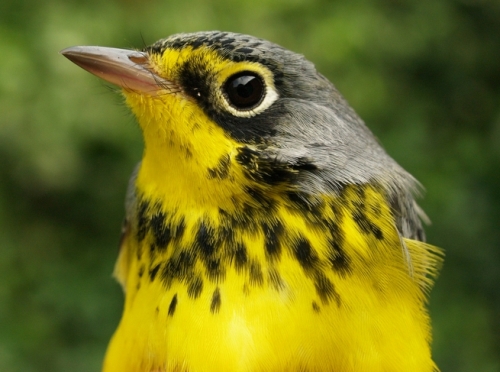 One of the starts of the first week of our sixth fall season was this gorgeous after-hatch-year male Canada Warbler. (Photo by Simon Duval)
One of the starts of the first week of our sixth fall season was this gorgeous after-hatch-year male Canada Warbler. (Photo by Simon Duval)
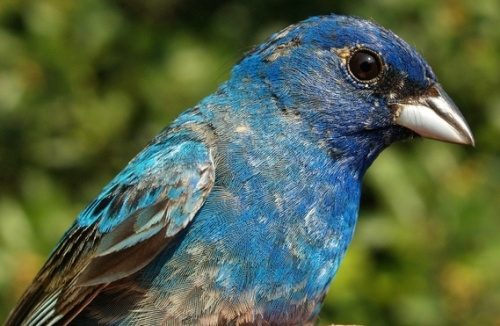 Fall migration always brings us a variety of interesting opportunities to observe birds in active molt. Although Indigo Bunting is one of the species that peaks in this first week of the season, we regularly see them in small numbers as late as October, and it’s rare we get more than a couple of them that look similar! On the other hand, we won’t see most of our Swainson’s Thrushes until past the midpoint of our season, but the one photographed below continues our trend of catching a small number of molt migrants in early August – essentially adults that have headed south from their breeding grounds and have chosen to replace their flight feathers at MBO instead. (Photos by Simon Duval)
Fall migration always brings us a variety of interesting opportunities to observe birds in active molt. Although Indigo Bunting is one of the species that peaks in this first week of the season, we regularly see them in small numbers as late as October, and it’s rare we get more than a couple of them that look similar! On the other hand, we won’t see most of our Swainson’s Thrushes until past the midpoint of our season, but the one photographed below continues our trend of catching a small number of molt migrants in early August – essentially adults that have headed south from their breeding grounds and have chosen to replace their flight feathers at MBO instead. (Photos by Simon Duval)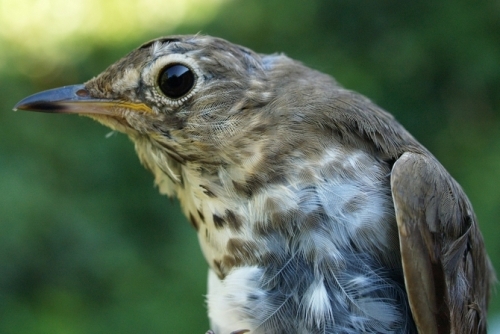
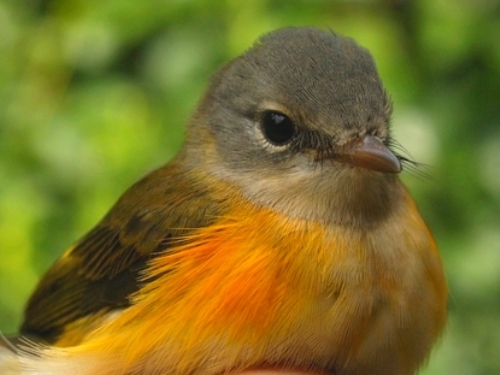 Beginning last fall we started to record the “armpit” colour of American Redstarts using a standard colour chart, in an effort to assess whether it can be reliably used as an aid to sex determination. This individual has the brightest orange of any we’ve seen. (Photo by Simon Duval)
Beginning last fall we started to record the “armpit” colour of American Redstarts using a standard colour chart, in an effort to assess whether it can be reliably used as an aid to sex determination. This individual has the brightest orange of any we’ve seen. (Photo by Simon Duval)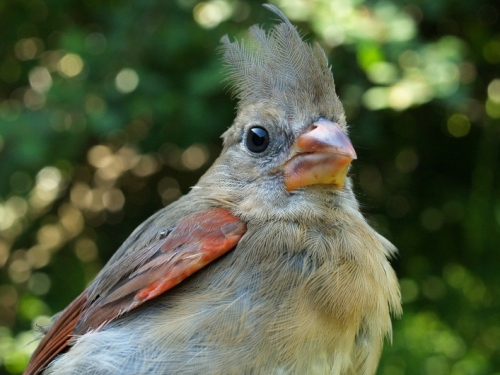 We often band a few Northern Cardinals in the early part of the season, most commonly the offspring of the local pairs. (Photo by Simon Duval)
We often band a few Northern Cardinals in the early part of the season, most commonly the offspring of the local pairs. (Photo by Simon Duval) A rather young Brown Thrasher, undergoing moult on the breast, and with a distinctly pale iris. (Photo by Simon Duval)
A rather young Brown Thrasher, undergoing moult on the breast, and with a distinctly pale iris. (Photo by Simon Duval) To illustrate last week’s comment about each Indigo Bunting in fall looking a bit different, here’s another male from this week, this time a second-year bird, as evident through the retained juvenile feathers on the wing, as shown below (the primary coverts, inner primaries, and outer secondaries). (Photos by Simon Duval)
To illustrate last week’s comment about each Indigo Bunting in fall looking a bit different, here’s another male from this week, this time a second-year bird, as evident through the retained juvenile feathers on the wing, as shown below (the primary coverts, inner primaries, and outer secondaries). (Photos by Simon Duval)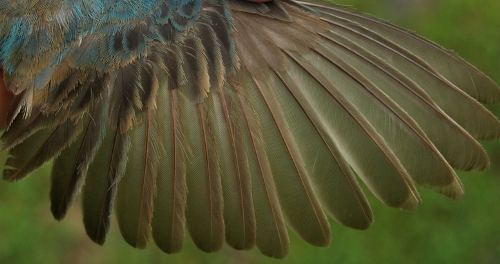
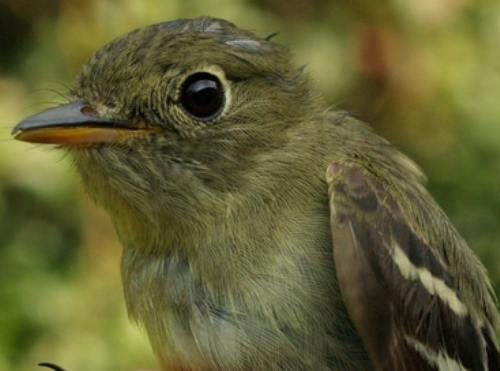 In fall we are often limited to classifying birds as hatch-year of after-hatch-year, but especially in August, we sometimes can still separate second-year birds from the mix. Such is the case with this Yellow-bellied Flycatcher, showing retained juvenile outer greater coverts, primary coverts, inner primaries, and outer secondaries. (Photo by Simon Duval)
In fall we are often limited to classifying birds as hatch-year of after-hatch-year, but especially in August, we sometimes can still separate second-year birds from the mix. Such is the case with this Yellow-bellied Flycatcher, showing retained juvenile outer greater coverts, primary coverts, inner primaries, and outer secondaries. (Photo by Simon Duval)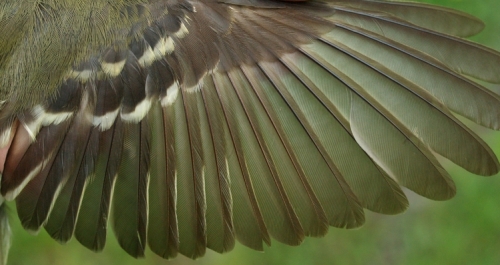
 One of four Blackburnian Warblers banded at MBO this week. This species has only been banded here in two of five previous fall seasons, and only once before have we had more than one individual in an entire season, so this week’s movement was significant. (Photo by Simon Duval)
One of four Blackburnian Warblers banded at MBO this week. This species has only been banded here in two of five previous fall seasons, and only once before have we had more than one individual in an entire season, so this week’s movement was significant. (Photo by Simon Duval) Above, Simon and Marie-Anne posing on Friday morning with a very special Indigo Bunting, which happened to become the 25,000th bird banded at MBO. (Photo by André Boulianne)
Above, Simon and Marie-Anne posing on Friday morning with a very special Indigo Bunting, which happened to become the 25,000th bird banded at MBO. (Photo by André Boulianne)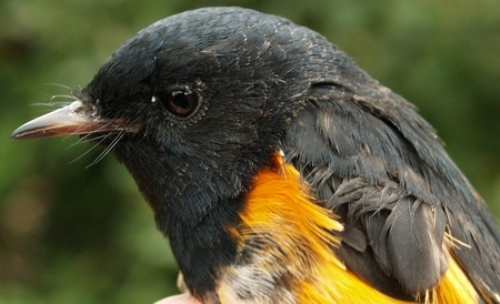
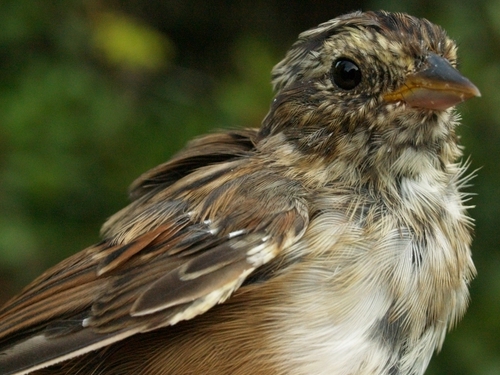 In 2006, we began to notice that some hatch-year Song Sparrows at MBO were replacing their primaries and primary coverts, contrary to what is suggested about their molt in the literature. Over the course of a couple of years, we realized this was fairly common, and we published a paper on the subject in North American Bird Bander (33: 1-6) and provided supplementary information on our
In 2006, we began to notice that some hatch-year Song Sparrows at MBO were replacing their primaries and primary coverts, contrary to what is suggested about their molt in the literature. Over the course of a couple of years, we realized this was fairly common, and we published a paper on the subject in North American Bird Bander (33: 1-6) and provided supplementary information on our 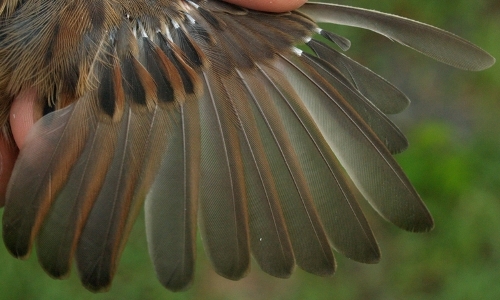
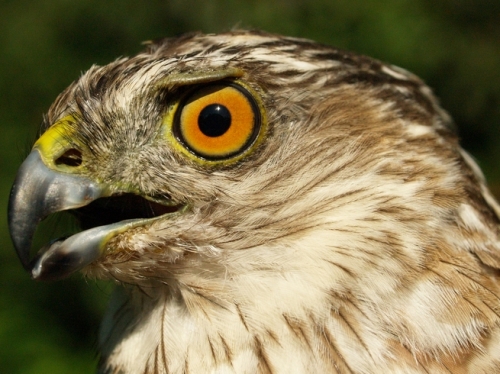 This second-year female Sharp-shinned Hawk was one of the highlights of week Although her plumage was still largely brown except for a few new gray feathers, her iris is distinctly more orange than the yellow of hatch-year individuals. (Photo by Simon Duval)
This second-year female Sharp-shinned Hawk was one of the highlights of week Although her plumage was still largely brown except for a few new gray feathers, her iris is distinctly more orange than the yellow of hatch-year individuals. (Photo by Simon Duval) This remarkably darkly-marked male Canada Warbler was one of another four of its kind banded this week, bringing the season total to a record 28, an encouraging sign for a species designated as Threatened in Canada in 2009. (Photo by Simon Duval)
This remarkably darkly-marked male Canada Warbler was one of another four of its kind banded this week, bringing the season total to a record 28, an encouraging sign for a species designated as Threatened in Canada in 2009. (Photo by Simon Duval)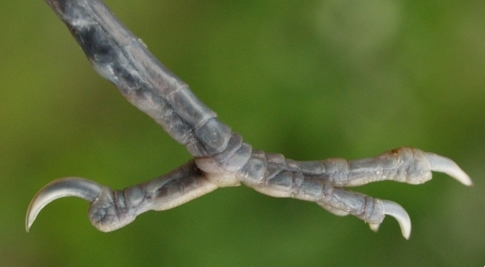 This is the somewhat misshapen and largely non-functional right tarsus and foot of a Red-eyed Vireo that we captured with this existing injury in August last year and therefore banded on the left leg instead. Recovering it this week after more than a year demonstrated its ability to survive despite this handicap. (Photo by Simon Duval)
This is the somewhat misshapen and largely non-functional right tarsus and foot of a Red-eyed Vireo that we captured with this existing injury in August last year and therefore banded on the left leg instead. Recovering it this week after more than a year demonstrated its ability to survive despite this handicap. (Photo by Simon Duval)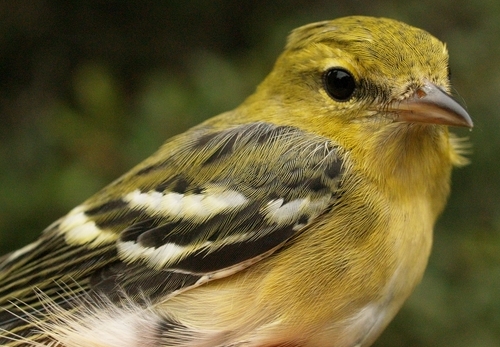 Bay-breasted Warbler is one of the least common warblers at MBO. In terms of numbers banded, it ranks 21st out of 25 species, with a total of only 19 individuals since 200 This after-hatch-year female was one of two Bay-breasted Warblers banded this week. (Photo by Simon Duval)
Bay-breasted Warbler is one of the least common warblers at MBO. In terms of numbers banded, it ranks 21st out of 25 species, with a total of only 19 individuals since 200 This after-hatch-year female was one of two Bay-breasted Warblers banded this week. (Photo by Simon Duval)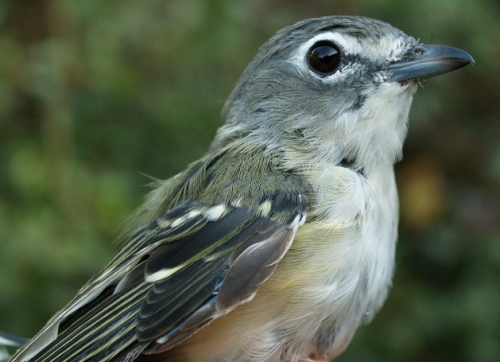 Blue-headed Vireos typically do not peak at MBO until late September, and we suspect most are migrants from some distance to the north. The adult above matches the earliest fall banding date for MBO, and the fact that it was in active molt (some feather shafts can be seen in the photo) suggests it may have nested nearby, perhaps in the Arboretum. (Photo by Simon Duval)
Blue-headed Vireos typically do not peak at MBO until late September, and we suspect most are migrants from some distance to the north. The adult above matches the earliest fall banding date for MBO, and the fact that it was in active molt (some feather shafts can be seen in the photo) suggests it may have nested nearby, perhaps in the Arboretum. (Photo by Simon Duval)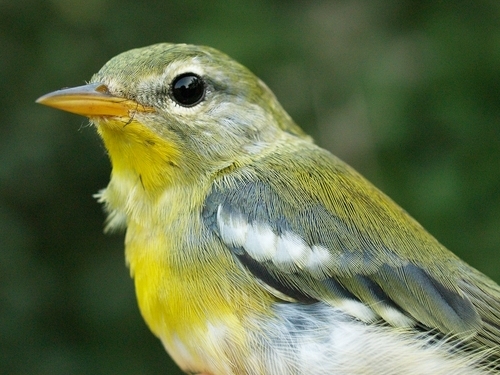 Our first Northern Parula of the fall, a hatch-year female. Both last year and in 2007 we banded just a single Northern Parula during fall migration, so we are hoping that this will not be the last one we see this year. (Photo by Simon Duval)
Our first Northern Parula of the fall, a hatch-year female. Both last year and in 2007 we banded just a single Northern Parula during fall migration, so we are hoping that this will not be the last one we see this year. (Photo by Simon Duval)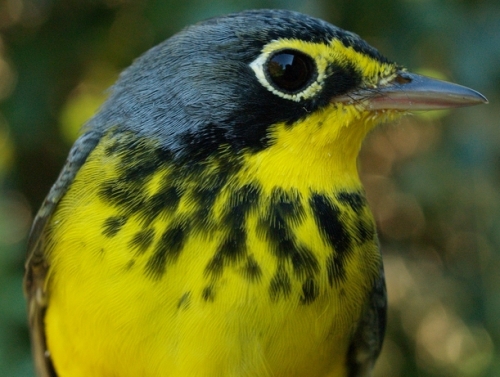 Canada Warblers have featured prominently in the weekly updates this fall, but as long we keep banding such fine-looking individuals, it’s tough to resist the urge to share them here. With another 5 banded this week, the season total has grown to 33, nearly 40% higher than the previous record high for the fall season. (Photo by Simon Duval)
Canada Warblers have featured prominently in the weekly updates this fall, but as long we keep banding such fine-looking individuals, it’s tough to resist the urge to share them here. With another 5 banded this week, the season total has grown to 33, nearly 40% higher than the previous record high for the fall season. (Photo by Simon Duval) Another warbler on pace for a record season this fall is Northern Waterthrush, also currently standing at 33 banded since the beginning of August. Back in 2006 we banded 39 of them in fall, but in every other year the fall count has ranged between 16 and 21. We typically continue to band them until mid/late September, so the 2010 total is likely to grow further. (Photo by Simon Duval)
Another warbler on pace for a record season this fall is Northern Waterthrush, also currently standing at 33 banded since the beginning of August. Back in 2006 we banded 39 of them in fall, but in every other year the fall count has ranged between 16 and 21. We typically continue to band them until mid/late September, so the 2010 total is likely to grow further. (Photo by Simon Duval)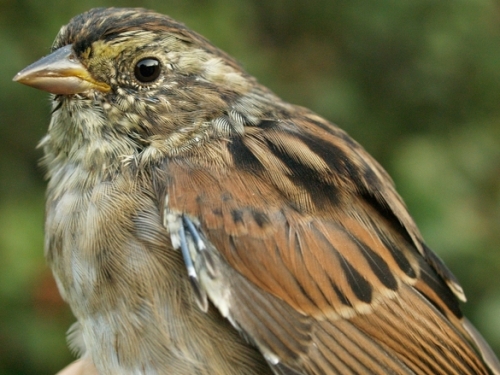 A
A 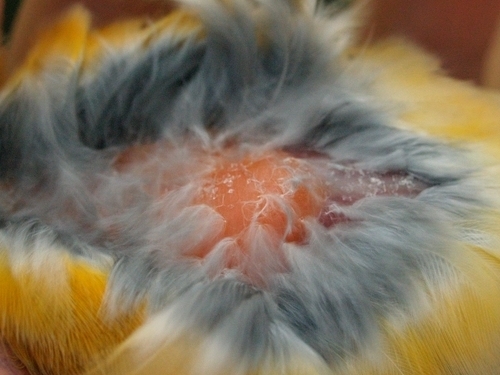 One of the pieces of data we record for each bird banded at MBO is fat level; this Baltimore Oriole was positively bursting with fat and is no doubt on the verge of taking off for its long-distance migration. (Photo by Simon Duval)
One of the pieces of data we record for each bird banded at MBO is fat level; this Baltimore Oriole was positively bursting with fat and is no doubt on the verge of taking off for its long-distance migration. (Photo by Simon Duval)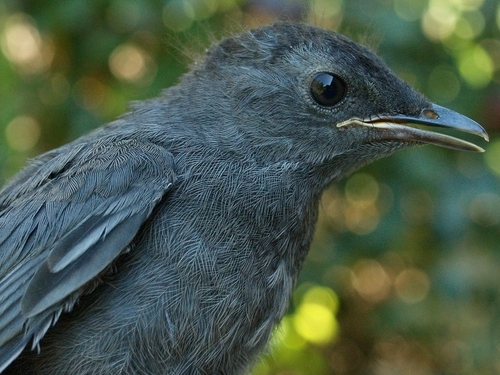 Meanwhile, some other species have nested late and still have young to care for, as shown by this barely-out-of-the-nest Gray Catbird banded this week. (Photo by Simon Duval)
Meanwhile, some other species have nested late and still have young to care for, as shown by this barely-out-of-the-nest Gray Catbird banded this week. (Photo by Simon Duval)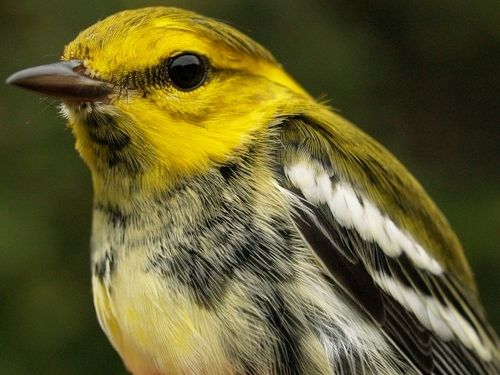 Among the many warblers banded at MBO this week, this was one of 4 Black-throated Green Warblers, a species we usually see only in relatively small numbers each fall. (Photo by Simon Duval)
Among the many warblers banded at MBO this week, this was one of 4 Black-throated Green Warblers, a species we usually see only in relatively small numbers each fall. (Photo by Simon Duval)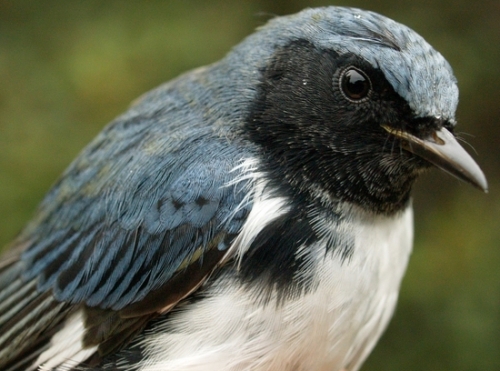 The “other” of the eastern black-throated warblers, this hatch-year male Black-throated Blue Warber was one of 10 banded this week, a good count for a species that often doesn’t peak in numbers until late September. (Photo by Simon Duval)
The “other” of the eastern black-throated warblers, this hatch-year male Black-throated Blue Warber was one of 10 banded this week, a good count for a species that often doesn’t peak in numbers until late September. (Photo by Simon Duval)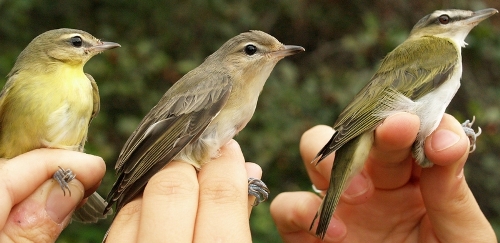 It isn’t often that we get an opportunity to compare three vireo species side by side, in part because Red-eyed Vireo is the only one we typically band in large numbers. In this photo, from left to right, we have Philadelphia Vireo (average 5 banded each fall), Warbling Vireo (average 6), and Red-eyed Vireo (average 69). Note that the Philadelphia Vireo has a distinctly darker lore than the Warbling Vireo, and the yellow extends across the breast (some Warbling Vireos have more yellow than the individual in this photo, but it isn’t as bold or extensive). (Photo by Simon Duval)
It isn’t often that we get an opportunity to compare three vireo species side by side, in part because Red-eyed Vireo is the only one we typically band in large numbers. In this photo, from left to right, we have Philadelphia Vireo (average 5 banded each fall), Warbling Vireo (average 6), and Red-eyed Vireo (average 69). Note that the Philadelphia Vireo has a distinctly darker lore than the Warbling Vireo, and the yellow extends across the breast (some Warbling Vireos have more yellow than the individual in this photo, but it isn’t as bold or extensive). (Photo by Simon Duval)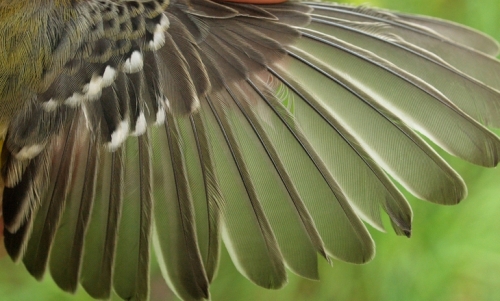 Here’s the lates in our continuing series of photos documenting unusual molt patterns. Magnolia Warblers generally replace all of their greater coverts during their preformative molt, but in this case the outer two juvenile feathers have been retained, though the carpal covert (above and to the right) has been replaced and is contrastingly dark and gray-edged. (Photo by Simon Duval)
Here’s the lates in our continuing series of photos documenting unusual molt patterns. Magnolia Warblers generally replace all of their greater coverts during their preformative molt, but in this case the outer two juvenile feathers have been retained, though the carpal covert (above and to the right) has been replaced and is contrastingly dark and gray-edged. (Photo by Simon Duval) As we approach the middle of the season, it’s time to say farewell to many of the early migrants we’re not likely to see again until next May. We occasionally have banded Veery as late as week 7, but it could be that the one in the photo above was our last for 2010. (Photo by Simon Duval)
As we approach the middle of the season, it’s time to say farewell to many of the early migrants we’re not likely to see again until next May. We occasionally have banded Veery as late as week 7, but it could be that the one in the photo above was our last for 2010. (Photo by Simon Duval) In the midst of all the many neotropical migrants banded at MBO this week was this rather scruffy hatch-year male Northern Cardinal, likely a local bird. It is just beginning to acquire its red plumage through the preformative molt, and the molt limits on the wings are distinctly visible even from this angle. (Photo by Simon Duval)
In the midst of all the many neotropical migrants banded at MBO this week was this rather scruffy hatch-year male Northern Cardinal, likely a local bird. It is just beginning to acquire its red plumage through the preformative molt, and the molt limits on the wings are distinctly visible even from this angle. (Photo by Simon Duval)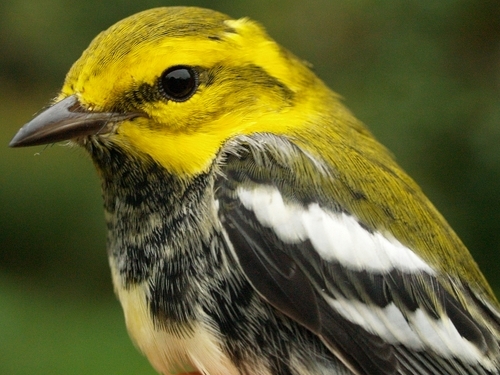 This is the second week in a row that we have featured a Black-throated Green Warbler, but with an after-hatch-year male as handsome as this, we couldn’t pass up the opportunity – note how much more black there is in the throat compared to the hatch-year male featured as
This is the second week in a row that we have featured a Black-throated Green Warbler, but with an after-hatch-year male as handsome as this, we couldn’t pass up the opportunity – note how much more black there is in the throat compared to the hatch-year male featured as 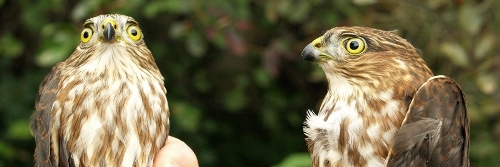 It is turning out to be a good season for Sharp-shinned Hawks at MBO. Catching two at once was unusual enough, but our total of 4 for the week was more than in some entire previous years, and the running total of 8 this fall is a new record high.. (Photo by Simon Duval)
It is turning out to be a good season for Sharp-shinned Hawks at MBO. Catching two at once was unusual enough, but our total of 4 for the week was more than in some entire previous years, and the running total of 8 this fall is a new record high.. (Photo by Simon Duval)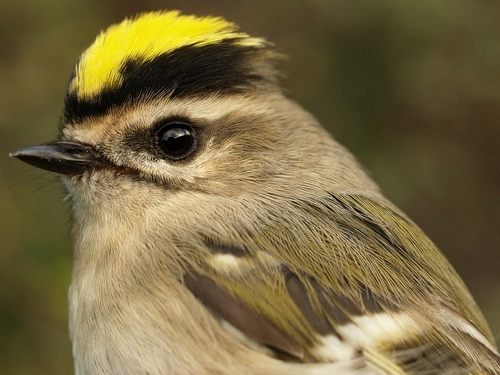 Our first Golden-crowned Kinglet of the fall, a sure sign of the season advancing. (Photo by Simon Duval)
Our first Golden-crowned Kinglet of the fall, a sure sign of the season advancing. (Photo by Simon Duval)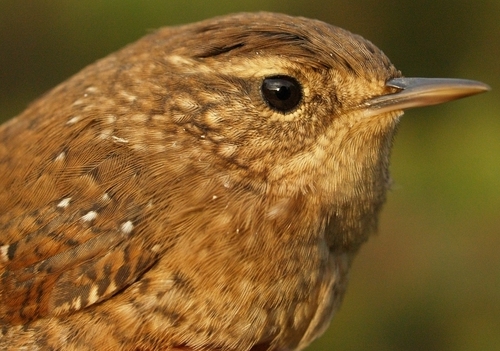 Winter Wren, another typical mid/late fall species at MBO. (Photo by Simon Duval)
Winter Wren, another typical mid/late fall species at MBO. (Photo by Simon Duval)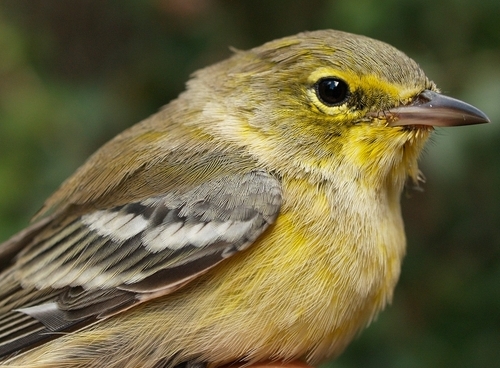 This Pine Warbler was the first “new” species banded at MBO since May 2008, bringing the list of species we have banded since 2004 to 106. (Photo by Simon Duval)
This Pine Warbler was the first “new” species banded at MBO since May 2008, bringing the list of species we have banded since 2004 to 106. (Photo by Simon Duval)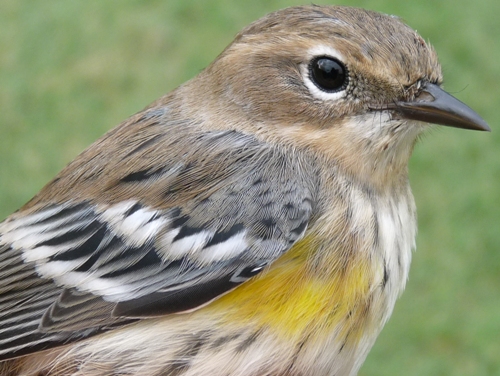 A Yellow-rumped Warbler, by far the most dominant bird this week, with an average of 125 banded and 239 observed daily. (Photo by Marcel Gahbauer)
A Yellow-rumped Warbler, by far the most dominant bird this week, with an average of 125 banded and 239 observed daily. (Photo by Marcel Gahbauer)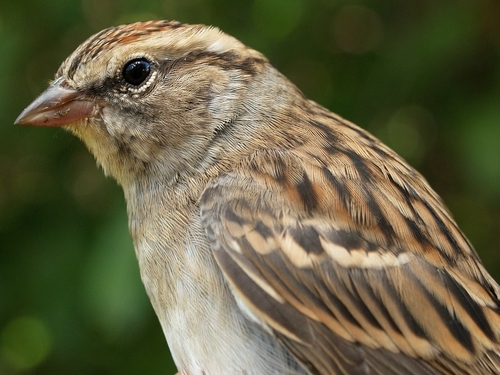 Closer to the opposite end of the spectrum of abundance, this was only the fourth Chipping Sparrow banded at MBO since the start of this fall. (Photo by Simon Duval)
Closer to the opposite end of the spectrum of abundance, this was only the fourth Chipping Sparrow banded at MBO since the start of this fall. (Photo by Simon Duval)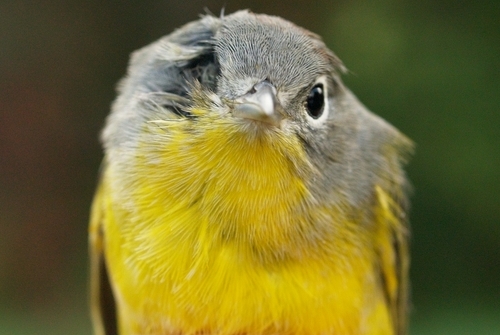 This after-hatch-year male Nashville Warbler was missing its right eye from some unknown previous encounter, but seems to be surviving fine. (Photo by Simon Duval)
This after-hatch-year male Nashville Warbler was missing its right eye from some unknown previous encounter, but seems to be surviving fine. (Photo by Simon Duval)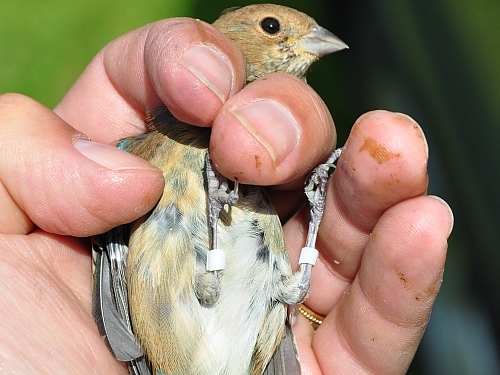 This after-hatch-year male Indigo Bunting took us by surprise thanks to the two plastic leg bands it was sporting when we caught it this week. Since it was not already carrying a standard metal leg band and the Canadian Bird Banding Office had no record of such a colour band scheme, we suspect that this may be a home-made banding approach, perhaps applied somether in the bird’s tropical winter range.. (Photo by Lance Laviolette)
This after-hatch-year male Indigo Bunting took us by surprise thanks to the two plastic leg bands it was sporting when we caught it this week. Since it was not already carrying a standard metal leg band and the Canadian Bird Banding Office had no record of such a colour band scheme, we suspect that this may be a home-made banding approach, perhaps applied somether in the bird’s tropical winter range.. (Photo by Lance Laviolette)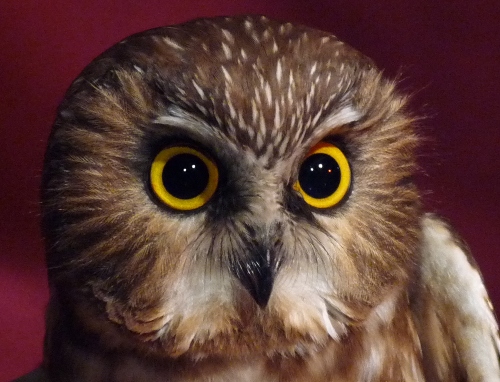 This week we resumed our Northern Saw-whet Owl Migration Monitoring Program. This year we will for the first time attempt to have full coverage of their migration season, from late September to early November (except for nights with rain or high winds). With 20 owls already banded this week (including an Eastern Screech Owl), we are off to a great start! (Photo by Marcel Gahbauer)
This week we resumed our Northern Saw-whet Owl Migration Monitoring Program. This year we will for the first time attempt to have full coverage of their migration season, from late September to early November (except for nights with rain or high winds). With 20 owls already banded this week (including an Eastern Screech Owl), we are off to a great start! (Photo by Marcel Gahbauer)
 Among the many hundreds of Yellow-rumped Warblers, this one stood out due to the amount of yellow scattered across its breast, as well as a few traces on its back and rump (see other photos). Although there was some speculation of it being a hybrid, most seem to think it is just a matter of atypical pigmentation. (Photo by Simon Duval)
Among the many hundreds of Yellow-rumped Warblers, this one stood out due to the amount of yellow scattered across its breast, as well as a few traces on its back and rump (see other photos). Although there was some speculation of it being a hybrid, most seem to think it is just a matter of atypical pigmentation. (Photo by Simon Duval)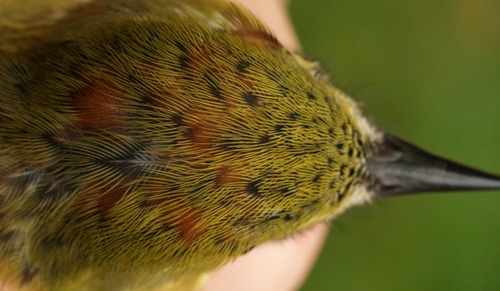 Speaking of unusual patterns, this one isn’t atypical for the bird in question, it just isn’t one we see very often at MBO. Try to figure out what it is; the identity will be revealed further on in the report. (Photo by Simon Duval)
Speaking of unusual patterns, this one isn’t atypical for the bird in question, it just isn’t one we see very often at MBO. Try to figure out what it is; the identity will be revealed further on in the report. (Photo by Simon Duval) Here’s another photo of the mystery bird from earlier in this week’s report – a boldly marked after-hatch-year male Bay-breasted Warbler. It was just the sixth Bay-breasted Warbler banded at MBO this fall, but yes, even that is a record high count for yet another warbler species. It also is the first time we have banded one as late as this (we caught it on the second last day of week 9, October 1). (Photo by Simon Duval)
Here’s another photo of the mystery bird from earlier in this week’s report – a boldly marked after-hatch-year male Bay-breasted Warbler. It was just the sixth Bay-breasted Warbler banded at MBO this fall, but yes, even that is a record high count for yet another warbler species. It also is the first time we have banded one as late as this (we caught it on the second last day of week 9, October 1). (Photo by Simon Duval)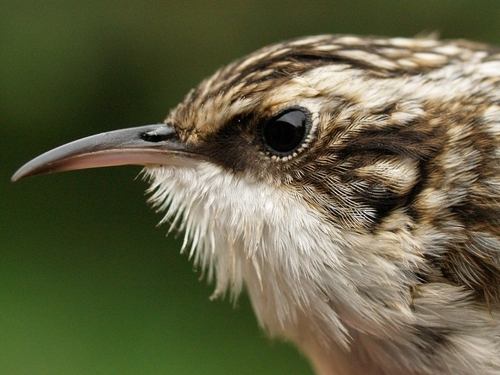 Like Bay-breasted Warblers, we never band a lot of Brown Creepers, our highest total for a season ever being just 12 of them. Late September and early October is the peak of their migration at MBO, and we were happy to have this one visit us amidst the flocks of warblers. (Photo by Simon Duval)
Like Bay-breasted Warblers, we never band a lot of Brown Creepers, our highest total for a season ever being just 12 of them. Late September and early October is the peak of their migration at MBO, and we were happy to have this one visit us amidst the flocks of warblers. (Photo by Simon Duval)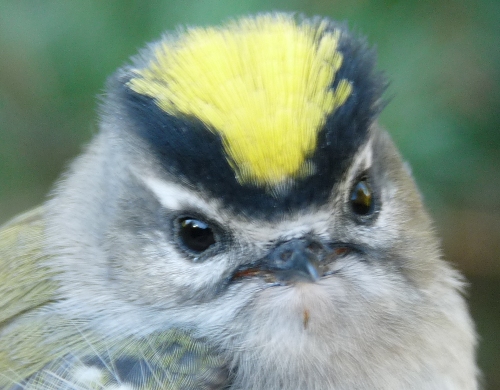 Golden-crowned Kinglets are the tiniest bird we band at MBO, and also considered one of the cutest by many of our volunteers not only due to their size, but also their high-pitched vocalizations and their tendency to flare their crests, as this female (above) and male (below) have done for the camera, nicely showing off their colours. (Photos by Marcel Gahbauer)
Golden-crowned Kinglets are the tiniest bird we band at MBO, and also considered one of the cutest by many of our volunteers not only due to their size, but also their high-pitched vocalizations and their tendency to flare their crests, as this female (above) and male (below) have done for the camera, nicely showing off their colours. (Photos by Marcel Gahbauer)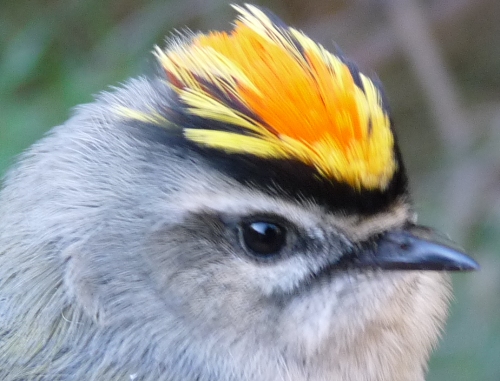
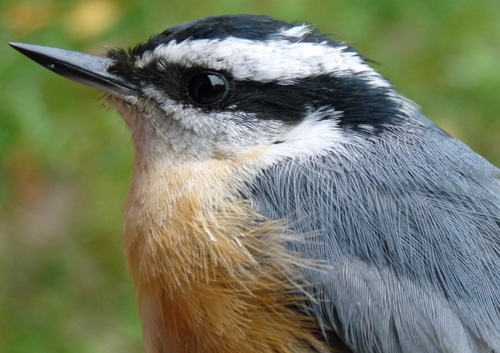 This Red-breasted Nuthatch was only the 7th ever banded at MBO. Although some other locations have reported large numbers on the move this fall, and this individual was practically bursting with fat to support a long migration, we haven’t seen any increase over our typically low numbers this fall … at least not yet. (Photo by Marcel Gahbauer)
This Red-breasted Nuthatch was only the 7th ever banded at MBO. Although some other locations have reported large numbers on the move this fall, and this individual was practically bursting with fat to support a long migration, we haven’t seen any increase over our typically low numbers this fall … at least not yet. (Photo by Marcel Gahbauer) On the heels of last week’s unusually marked Yellow-rumped Warbler, we had a peculiar looking Slate-colored Junco this week. In this case, we’re quite certain it is a hybrid with a White-throated Sparrow, based especially on the distinct white throat (above), but also the pattern on the tertials (below at left, in comparison with a White-throated Sparrow at right) which largely show the pattern of the White-throated Sparrow, but are grayer.
On the heels of last week’s unusually marked Yellow-rumped Warbler, we had a peculiar looking Slate-colored Junco this week. In this case, we’re quite certain it is a hybrid with a White-throated Sparrow, based especially on the distinct white throat (above), but also the pattern on the tertials (below at left, in comparison with a White-throated Sparrow at right) which largely show the pattern of the White-throated Sparrow, but are grayer. 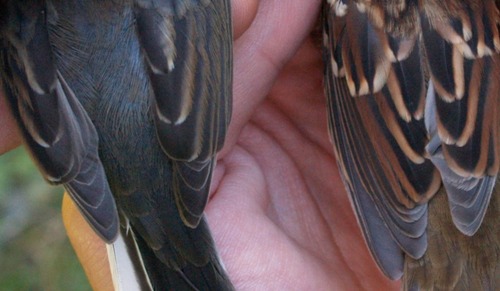
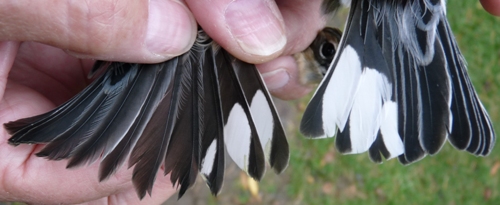 With so many Yellow-rumped Warblers coming through, we have had great opportunities (although little time) to compare among age and sex classes. In the example above, a hatch-year male on the left was narrower and more pointed rectrices than the after-hatch-year male on the right, and the extent of white on the outer feathers is also more limited on the younger bird. (Photo by Marcel Gahbauer)
With so many Yellow-rumped Warblers coming through, we have had great opportunities (although little time) to compare among age and sex classes. In the example above, a hatch-year male on the left was narrower and more pointed rectrices than the after-hatch-year male on the right, and the extent of white on the outer feathers is also more limited on the younger bird. (Photo by Marcel Gahbauer)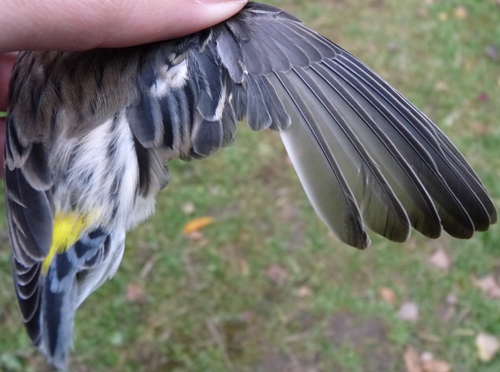 We have seen many examples this fall of after-hatch-year birds that haven’t quite completed their prebasic molt (e.g. below), but this Yellow-rumped Warbler was a special case. It was missing all of its secondaries on the right side, as well as its tail, but the left wing was fully intact. Presumably it had a narrow escape from a predator, likely not much more than a week before arriving at MBO, based on the extent of growth of the replacement feathers. Despite the apparent impediments, it flew away after banding without showing any lack of balance or power. (Photo by Marcel Gahbauer)
We have seen many examples this fall of after-hatch-year birds that haven’t quite completed their prebasic molt (e.g. below), but this Yellow-rumped Warbler was a special case. It was missing all of its secondaries on the right side, as well as its tail, but the left wing was fully intact. Presumably it had a narrow escape from a predator, likely not much more than a week before arriving at MBO, based on the extent of growth of the replacement feathers. Despite the apparent impediments, it flew away after banding without showing any lack of balance or power. (Photo by Marcel Gahbauer)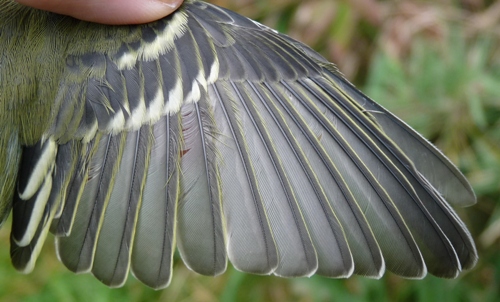 As noted above, we have seen quite a few after-hatch-year birds this fall that haven’t quite completed their molt, and in most cases the feathers not yet fully grown have been secondaries 4 through 6, as in the photo above. While we’ve noted this primarily in Yellow-rumped Warblers, we have also documented it in one Hermit Thrush, as well as this Blue-headed Vireo. (Photo by Marcel Gahbauer)
As noted above, we have seen quite a few after-hatch-year birds this fall that haven’t quite completed their molt, and in most cases the feathers not yet fully grown have been secondaries 4 through 6, as in the photo above. While we’ve noted this primarily in Yellow-rumped Warblers, we have also documented it in one Hermit Thrush, as well as this Blue-headed Vireo. (Photo by Marcel Gahbauer) Even before the last of the Yellow-rumped Warbler flocks moved on, MBO was invaded by another unusually abundant species, this time Black-capped Chickadee. (Photo by Marcel Gahbauer)
Even before the last of the Yellow-rumped Warbler flocks moved on, MBO was invaded by another unusually abundant species, this time Black-capped Chickadee. (Photo by Marcel Gahbauer)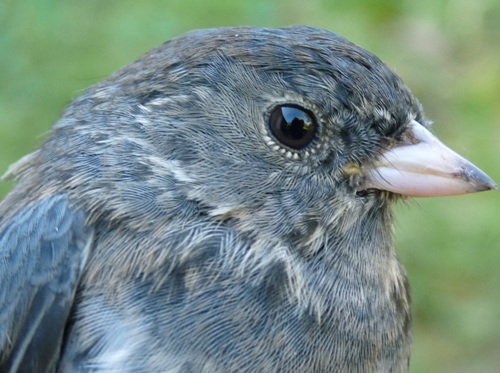 For the second week in a row we had a Slate-colored Junco that appears to be a hybrid. Although not as distinctly marked as last week’s apparent White-throated Sparrow hybrid, we suspect that may nonetheless be the parentage of this bird too (
For the second week in a row we had a Slate-colored Junco that appears to be a hybrid. Although not as distinctly marked as last week’s apparent White-throated Sparrow hybrid, we suspect that may nonetheless be the parentage of this bird too (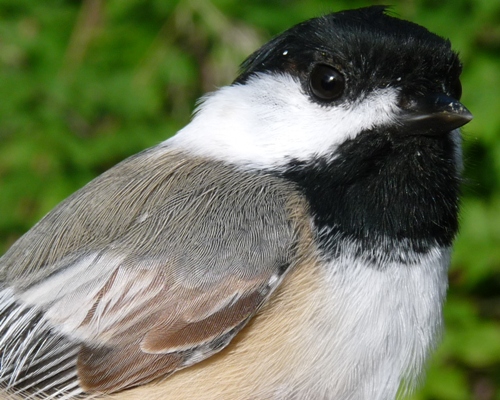 The odd-looking birds these days aren’t just limited to juncos – this Black-capped Chickadee has brown feathers on its wings! In this case we suspect it’s a plumage aberration of some sort rather than a matter of hybridization, but a curious pattern in any case; we also have posted
The odd-looking birds these days aren’t just limited to juncos – this Black-capped Chickadee has brown feathers on its wings! In this case we suspect it’s a plumage aberration of some sort rather than a matter of hybridization, but a curious pattern in any case; we also have posted 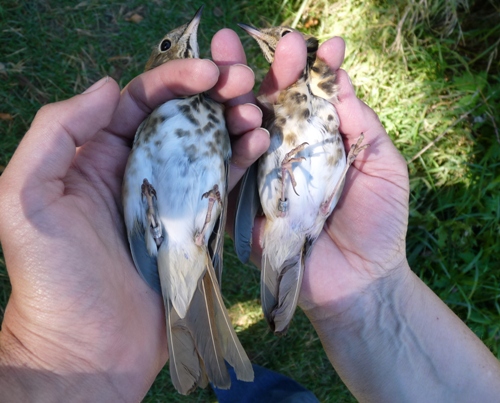 Another identification puzzle for us this week was the thrush at left in the photo above. In every aspect of its plumage it looked like a normal Hermit Thrush … it’s just that it was giant compared to the many others we have been banding, of which the one on the right is a typical example. (Photo by Marcel Gahbauer)
Another identification puzzle for us this week was the thrush at left in the photo above. In every aspect of its plumage it looked like a normal Hermit Thrush … it’s just that it was giant compared to the many others we have been banding, of which the one on the right is a typical example. (Photo by Marcel Gahbauer)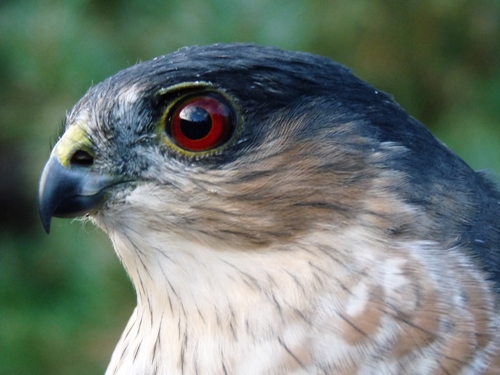 Although the oddities among the juncos, chickadees, and thrushes this week were exciting themselves, the thrill of banding this dashing after-second-year Sharp-shinned Hawk was a special treat, especially since we typically only catch hatch-year raptors. (Photo by Marcel Gahbauer)
Although the oddities among the juncos, chickadees, and thrushes this week were exciting themselves, the thrill of banding this dashing after-second-year Sharp-shinned Hawk was a special treat, especially since we typically only catch hatch-year raptors. (Photo by Marcel Gahbauer)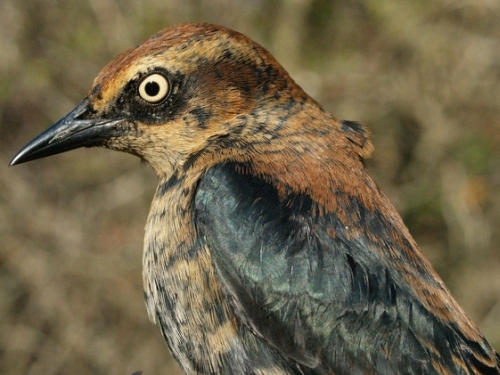 This Rusty Blackbird, caught on the final day of week 12, was the first one ever banded at MBO in fall, and only the seventh overall since 200(Photo by Simon Duval)
This Rusty Blackbird, caught on the final day of week 12, was the first one ever banded at MBO in fall, and only the seventh overall since 200(Photo by Simon Duval)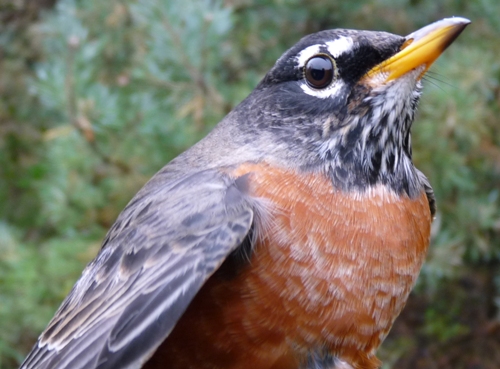 This time of year at MBO is always marked by large numbers of American Robins, often showing a remarkable range of variation in plumage. This after-hatch-year male was among the darkest and most richly coloured of those we banded. (Photo by Marcel Gahbauer)
This time of year at MBO is always marked by large numbers of American Robins, often showing a remarkable range of variation in plumage. This after-hatch-year male was among the darkest and most richly coloured of those we banded. (Photo by Marcel Gahbauer)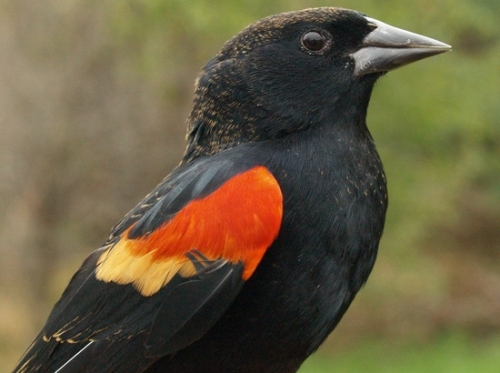 One of the Red-winged Blackbirds banded this week. (Photo by Simon Duval)
One of the Red-winged Blackbirds banded this week. (Photo by Simon Duval)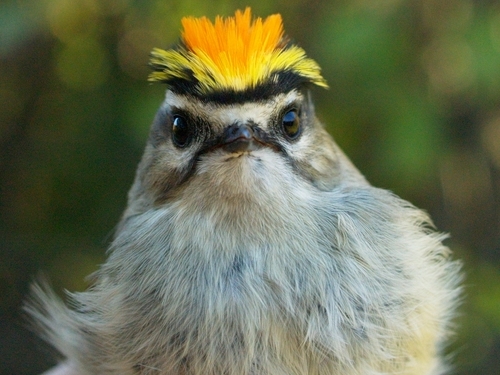 A male Golden-crowned Kinglet raising its crest at the camera. (Photo by Simon Duval)
A male Golden-crowned Kinglet raising its crest at the camera. (Photo by Simon Duval)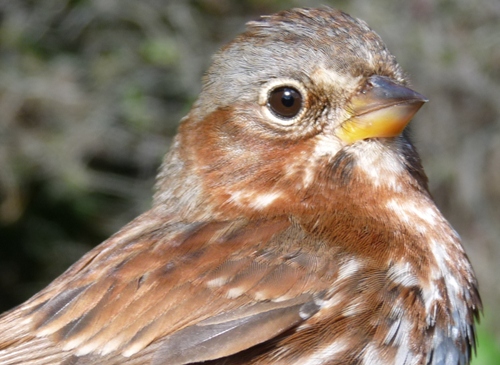 Two of the rusty-toned late season specialties at MBO – Fox Sparrow above, and American Tree Sparrow below. (Photos by Marcel Gahbauer)
Two of the rusty-toned late season specialties at MBO – Fox Sparrow above, and American Tree Sparrow below. (Photos by Marcel Gahbauer)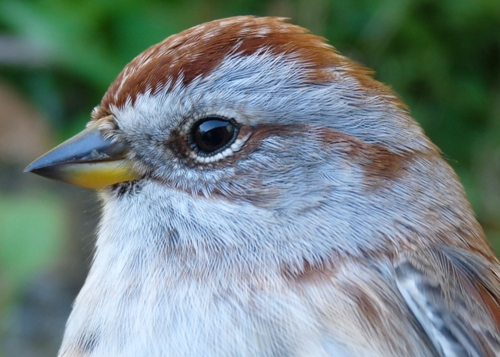
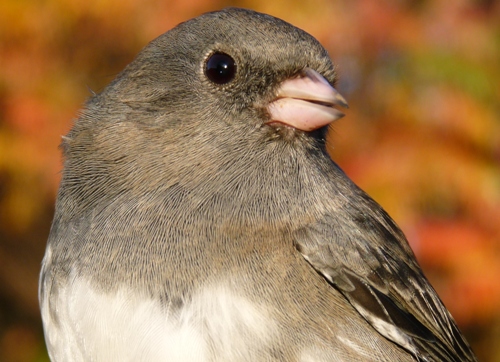 This week Slate-colored Junco became only the second species at MBO with more than 500 individuals banded in a single season of migration. (Photo by Marcel Gahbauer)
This week Slate-colored Junco became only the second species at MBO with more than 500 individuals banded in a single season of migration. (Photo by Marcel Gahbauer)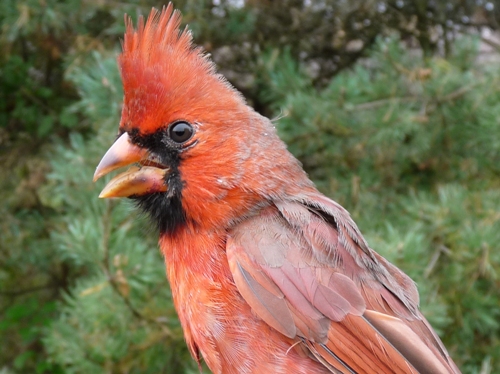 At a glance, the Northern Cardinal above could almost pass for an adult, except for a bit of a dusky smudge remaining on the bill. However, examination of the tail (below) shows a distinct molt limit between the broad and rounded basic rectrices that have been recently replaced (including r3 still growing) and the retained outermost three juvenile rectrices on either side that are browner, narrower, and more pointed. Within another few weeks, it would likely be impossible to tell this hatch-year bird apart from after-hatch-year cardinals. (Photos by Marcel Gahbauer)
At a glance, the Northern Cardinal above could almost pass for an adult, except for a bit of a dusky smudge remaining on the bill. However, examination of the tail (below) shows a distinct molt limit between the broad and rounded basic rectrices that have been recently replaced (including r3 still growing) and the retained outermost three juvenile rectrices on either side that are browner, narrower, and more pointed. Within another few weeks, it would likely be impossible to tell this hatch-year bird apart from after-hatch-year cardinals. (Photos by Marcel Gahbauer)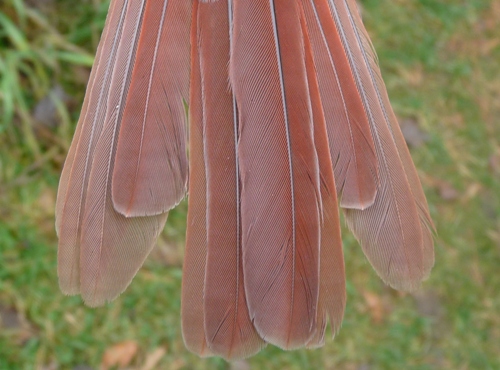
 A group breakfast was held at MBO on the final morning to recognize this fall’s census team for their important contributions throughout the season. (Photo by Rodger Titman)
A group breakfast was held at MBO on the final morning to recognize this fall’s census team for their important contributions throughout the season. (Photo by Rodger Titman) Pat helping with the breakfast preparations on the stove inside. (Photo by Simon Duval)
Pat helping with the breakfast preparations on the stove inside. (Photo by Simon Duval) A quick shot taken while “unwrapping” a saw-whet for banding. A reminder that individual owls are now available through MBO’s
A quick shot taken while “unwrapping” a saw-whet for banding. A reminder that individual owls are now available through MBO’s